10-Day Itinerary in Spain: A Trip That Captures the Essence of Spain!

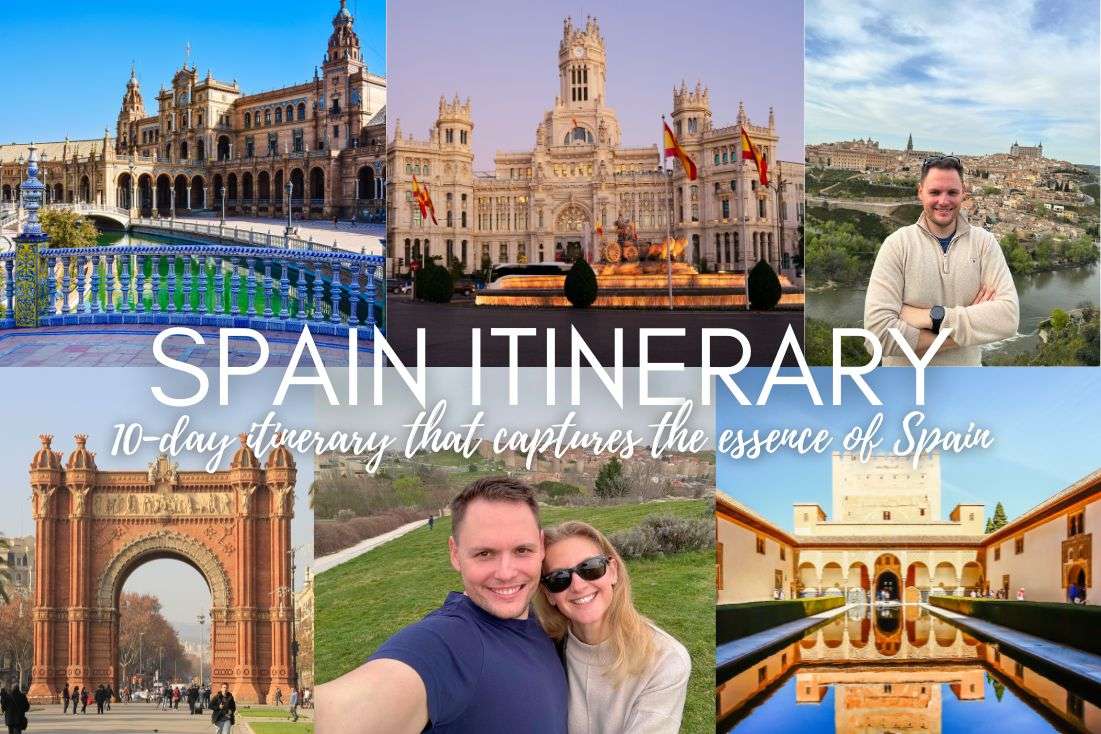
Welcome to Spain, a country I’ve explored more thoroughly than most people explore their own backyard. After visiting over 50 countries, Spain still pulls me back time and time again, and I think I now know a good thing or two about it.
With over six months spent traversing its diverse regions—from the bustling streets of Madrid and Barcelona to the sun-soaked charm of Sevilla and Córdoba—I’ve crafted (seriously, it’s the best you’ll find) a 10-day itinerary that captures the essence of Spain. We’ll hit the highlights and skip the fluff, ensuring you experience the best in the most efficient way possible. Hey, you only have 10 days in Spain, it’s obvious you’ll need to skip a few spots! So, buckle up—Spain awaits!
Overview of your 10-day trip to Spain itinerary
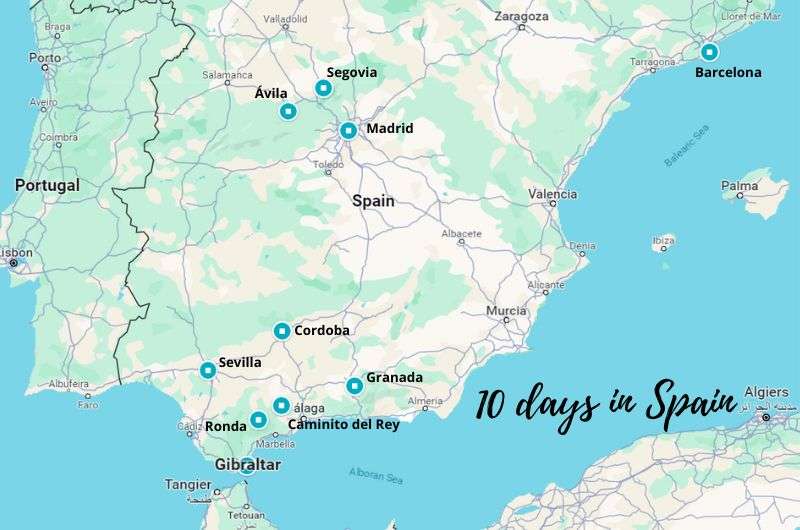
10 destinations in 10 days... are you up for it?
Here is your itinerary for 10 fantastic days in Spain, covering the top highlights across the regions. You’ll travel by train and rental car, and sleep in 4 different spots. All the logistics are detailed below. Enjoy!
Day 0: Fly into Barcelona (sleep in Barcelona)
Day 1: Barcelona (sleep in Barcelona)
Day 2: Train to Madrid, El Escorial (sleep in Madrid)
Day 3: Madrid (sleep in Madrid)
Day 4: Avila (sleep in Madrid)
Day 5: Segovia (sleep in Madrid)
Day 6: Train to Cordoba, half day there, train to Sevilla (sleep in Sevilla)
Day 7: Sevilla (sleep in Sevilla)
Day 8: Granada (sleep near Malaga)
Day 9: Caminito del Rey + Ronda (sleep near Malaga)
Day 10: Gibraltar (sleep near Malaga)
Day D: Departure from Malaga
Before you start traversing Spain, check out these guides to smooth your journey even before you get there:
21 FAQs and Tips for the First-time Flyer
Long-Haul Flight Survival Guide
20 FAQs and Tips for Packing a Carry-On
Day 0: Arrival in Barcelona
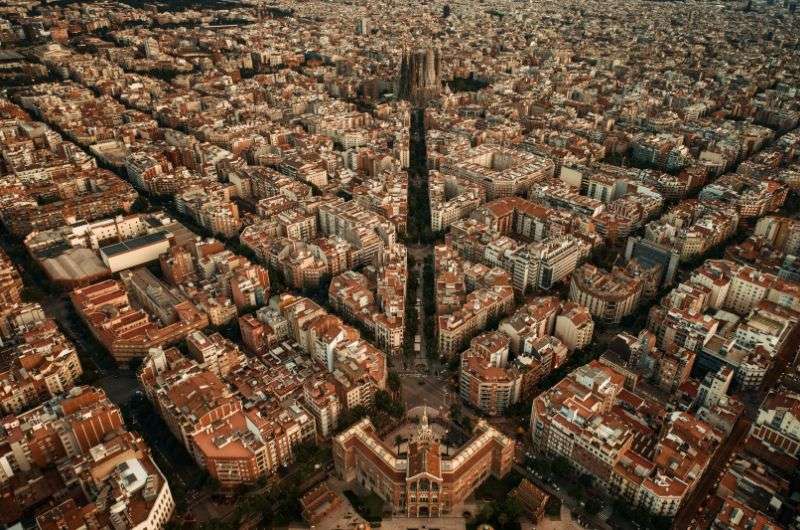
Welcome to Barcelona!
Main sites visited on day 0: BCN airport, your hotel, and maybe Montjuïc Hill and cable car
Hotel recommendations—book for 2 nights: Hotel La Pau | INNSiDE by Meliá Barcelona Apolo
Touchdown in Barcelona! After a long flight, you'll want to get to your hotel (my tips: Hotel La Pau or INNSiDE by Meliá Barcelona Apolo) and stretch those legs. Thankfully, Barcelona-El Prat Airport (BCN) is just south of the city and there are easy transportation options available.
How to get from Barcelona airport to city center
Which mode of transportation you take from the airport will depend on which terminal you arrive at and where your hotel is located in the city, so let me lay out the basic options and you can use Google Maps to help you with the rest:
- Metro: The L9 Sud line connects both terminals to key locations in the city. A ticket costs EUR 5.15, and it takes about 30 minutes.
- Train: The RENFE R2 Nord train departs from Terminal 2, heading to Barcelona Sants, Passeig de Gràcia, and El Clot-Aragó stations. Tickets cost EUR 4.60, and the journey is roughly 25 minutes.
- Taxi: A convenient option costing around EUR 30, getting you to central Barcelona in 20-30 minutes, depending on traffic.
- Aerobus: This shuttle service departs every 5-10 minutes from both terminals. Tickets are EUR 5.90, and it’s a direct service that takes about 35 minutes to reach Plaça de Catalunya.
Pro Tip: If you’re arriving late, the N17 and N18 night buses are reliable and run all night long. Which for me translates to: take a taxi. Come on, night buses? No thank you.
Bonus sightseeing on arrival day: Montjuïc Hill
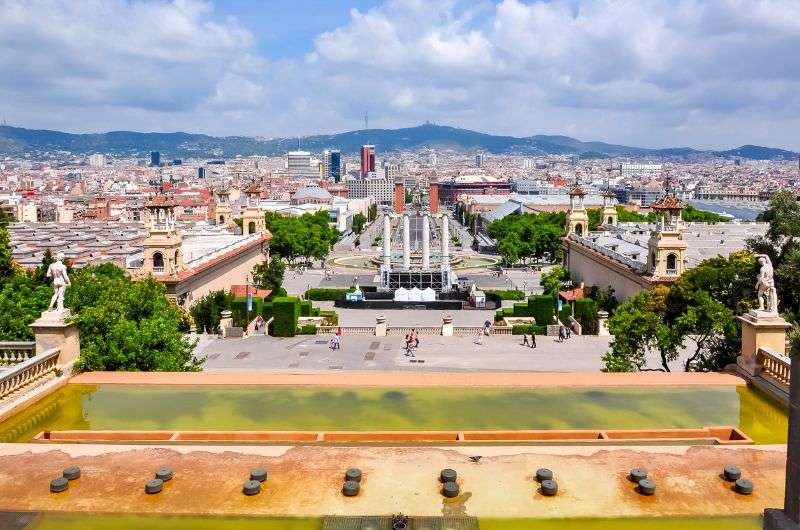
Montjuic Hill
If you arrive in Barcelona at a decent time and feel up for it, squeeze in some extra sightseeing in Barcelona. Head over to Montjuic Hill, where you can catch a cable car ride for a stunning panoramic view of the city. The cable car runs from the base to Montjuïc Castle for around EUR 14 round trip. While you're there, take a stroll down to the nearby beach area—perfect for soaking in the evening air and kick-starting your Barcelona adventure.
Day 1: Exploring Barcelona’s Architectural Marvels
This map shows the highlights of day 1 (you'll want to grab a taxi for some bits). Get it already planned out on Google Maps
Main sites visited on day 1: Cathedral of Barcelona, Casa Batlló, Casa Milà, La Sagrada Familia, Park Güell, Barceloneta Beach
Hotel recommendations: Hotel La Pau | INNSiDE by Meliá Barcelona Apolo
Further reading:
Day 1, Stop 1: Cathedral of Barcelona
- Time spent here: 30 minutes
- Opening hours: 8:30 am–7:30 pm (weekdays), 8:30 am–8:00 pm (weekends)
- Price: EUR 7 (free early morning and late afternoon)
Start your walk at the Cathedral of Barcelona, right in the heart of the Gothic Quarter. I’ve always found this spot a perfect intro to Barcelona—it's steeped in history and surrounded by charming streets that scream "Old Europe." The Barri Gòtic (Gothic Quarter) is the center of the old town of Barcelona. This is where the streets are narrow and everything is wonderfully old.
The cathedral itself is a Gothic masterpiece and interior doesn’t disappoint. Incredible ornate façade? Check. Intricate carvings? Check. Soaring spires crawling up to the skies? Check. And I haven't even started about the inside of the Cathedral. The cloister, with its 13 geese honking around (representing the age of Saint Eulalia at her martyrdom), always makes me chuckle—who knew geese had such an important job? And how often do they need to replace them??
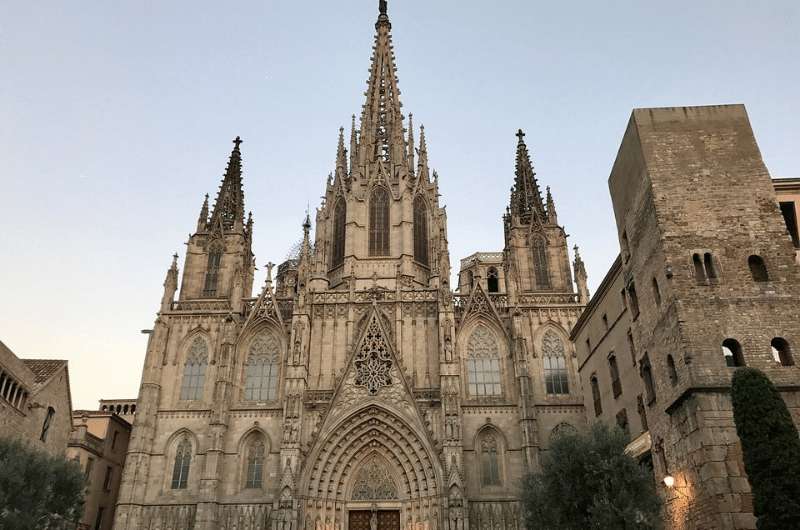
Barcelona Cathedral with a little bit of the Casa de l'Ardiaca on the right
If you're up for a bit of exercise, take the stairs or elevator to the rooftop. The views over the Gothic Quarter are worth every euro, especially early in the morning when the city is just waking up—remember, Spain wakes up pretty late!
And if you’re lucky enough to visit on a Sunday, catch the traditional Sardana dance in the square outside—nothing like a bit of local culture to kickstart your 10 days in Spain.
Day 1, Stop 2: Casa Batlló
- Distance from last stop: 1.5 km (0.9 mi), a 20-minute walk
- Time spent here: 1.5 hours
- Opening hours: 9:00 am – 8:15 pm daily
- Price: from EUR 29
Next, head over to Casa Batlló on Passeig de Gràcia, one of my favorite Gaudí creations. The first time I saw it, I couldn’t help but think, "Is this building smiling at me?" The wavy lines, vibrant colors, and quirky balconies make it feel like something straight out of a Dr. Seuss book.
The roof is a dragon’s back, ok? The locals call it the house of bones because of how skeletal it looks. The facade is decorated with broken tiles, a gazillion of them, and the windows on the two bottom floors are oval... err, round... just weird-shaped, like something out of a fairy tale. The retro kind of fairy tale that has a lot of death in it.
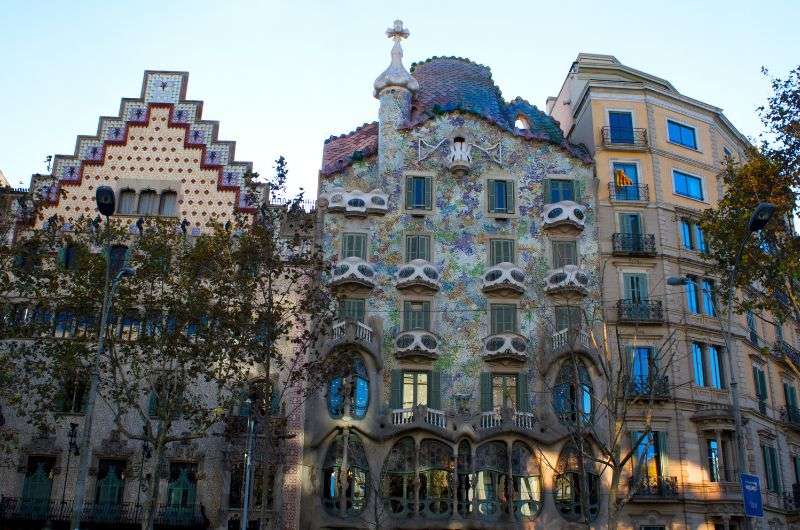
One of my fave Gaudí buildings, Casa Batlló
But don’t just stand there, go inside! Don't skip it, this is a must-do. The interior is just as fascinating as the exterior and the self-guided tour is amazing. Seriously, I cannot recommend it highly enough. I can’t imagine what it was like inside Gaudí’s mind, but being inside Casa Batlló is the closest you will get to being inside his brain. It’s colorful, it’s outrageous, it’s all over the place. And I mean that literally, since in the last room there are projections on every surface and you are unconditionally immersed in it all. The 10D Experience really blew me away; it's an immersive journey that shows just how ahead of his time Gaudí was.
A tip from experience: book your tickets online.
Day 1, Stop 3: Casa Milà (La Pedrera)
- Distance from last stop: 500 m (0.3 mi), an 8-minute walk
- Time spent here: 5 minutes to look from the outside
- Opening hours: Daily 9:00 am–8:30 pm
- Price: EUR 25
Casa Milà, or as the locals call it, La Pedrera (“the stone quarry”), is the last private residence that Gaudí designed, and when it was built, the locals hated it. This building isn’t as ornate as some of the other buildings he’s designed, but it’s still obviously Gaudí.
Now, you only have a day in Barcelona, so since you’ve already “visited Gaudí” at Casa Batlló, I’ll tell you to skip the interior of Cala Milà this time around. Leave it for another trip to Spain—I promise you’ll be back!
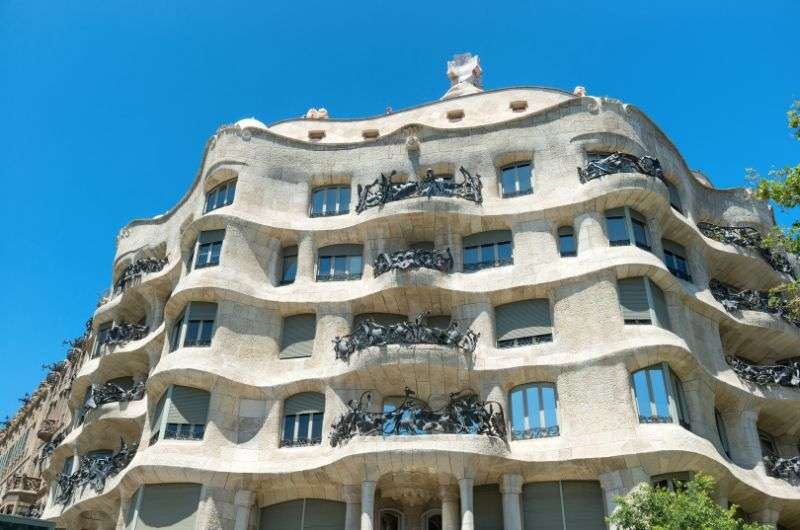
Casa Milà
Just fyi: inside you‘ll find the Gaudí interpretation center—which is basically a museum about Gaudí's work and inspiration. What I liked most was the attic—you’ll feel like you’re inside a whale! And then also the model of Sagrada Familia which shows in a completely genius way the structural properties of it. You can take a guided tour if you want, but there is no problem with visiting the house by yourself with an audio guide—which I strongly recommend. The basic tour will take you through the museum, the courtyards, and the roof.
The rooftop is also really cool. The chimneys are practically sculptures. I love coming here at night; the illuminated rooftop is something out of a dream, and the views over Barcelona are stunning… but we’re not doing that today. You’d need more time in Barcelona; here, check out my 5-day Barcelona itinerary if you want to plan a dedicated trip in the future.
Get a good look of the exterior and continue on your walk.
Day 1, Stop 4: La Sagrada Familia
- Distance from last stop: 1.4 km (1 mi), a 20-minute walk or 10-minute metro ride
- Time spent here: 1.5 hours
- Opening hours: Daily 9:00 am–8:00 pm
- Price: EUR 26 (basic entry)
Next up is the one and only La Sagrada Familia—Gaudí’s unfinished masterpiece and perhaps the most iconic landmark in Barcelona. Every time I visit, I’m blown away by it despite the “work-in-progress” vibe.
You can walk to Sagrada Familia in about 20 minutes from Casa Milà, or hop on the metro to speed things along a bit.

Barcelona's endlessly constructed jewel—Sagrada Familia
When you get there, stare. I promise you will stare a lot. The exterior is a narrative in stone, with the Nativity and Passion facades each telling different parts of the biblical story. I could spend hours just taking in the intricate details of the sculptures… but we ain’t got that kind of time luxury, so keep moving.
Tip: Beware of pickpockets in the park in front of the cathedral.
Now it’s time to go be overwhelmed inside the Sagrada Familia. You can even say hi to your pal Gaudí yourself. He's buried in the crypt inside the basilica. I would say RIP, but I'm not sure how much of the P he is getting there with all the construction over all these years.
One step inside and it’s like you’ve been transported into another world. The soaring columns, which Gaudí designed to resemble a forest, stretch up to a kaleidoscope of stained-glass windows that bathe the interior in an ethereal glow. If you can, book a guided tour—it’s worth it to get the backstory on all the little details that you’d otherwise miss.
And definitely plan your visit for midday; the sunlight streaming through those windows is nothing short of magical. If you’re following my itinerary (not sure why you wouldn’t—it’s the best on the internet!), the timing is just right for this spectacle.
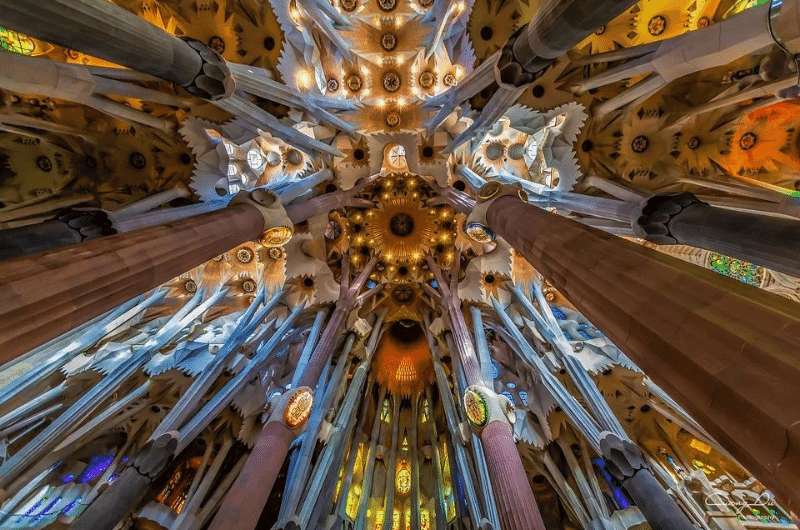
The incredible interior architecture of the Sagrada Familia
Pro tip: Tickets sell out fast, especially during peak tourist season, so book in advance online. I mean it—I missed out on the interior of the Sagrada Familia TWICE because I couldn’t get tickets. Don’t be like me! If you’re feeling adventurous, opt for the tower tour (EUR 36), which offers epic views of Barcelona. This makes sense especially if you didn’t get to visit Montjuïc Hill yesterday and see the views from there.
When will Sagrada Familia be finished?
As of August 2024, the Sagrada Familia is nearing completion, with 18 of the planned 18 towers now finished (woop, after over 140 years!), including the tallest tower dedicated to Jesus Christ, which reaches 172.5 m (560 ft). However, the final completion date is set for 2026 (100 years after Gaudí’s death), delayed by the pandemic, and work remains on the central towers and some interior elements. Nobody believes it will really be done by then though.
Day 1, Stop 5: Park Güell
- Distance from last stop: 2.1 km (1.3 mi), a 10-minute taxi ride or a 30-minute walk
- Time spent here: 1.5 hours
- Opening hours: 9:30 am–7:30 pm daily
- Price: EUR 10
Park Güell is a large, hilly, park area filled with stairways, buildings and hidden nooks and crannies, all in Gaudí’s typical style of millions of tiles, colors, and melting stuff that transport you into Wonderland. It’s rightfully one of the most famous public spaces in the world.
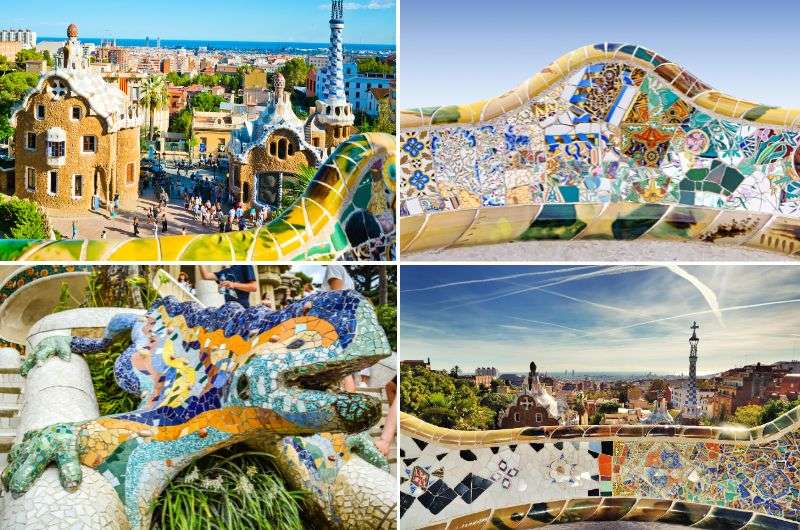
Park Güell is another monumental work of Gaudí
I used to come here all the time when I worked in Barcelona (this is way back when there was no entry fee). It’s the first of Gaudí’s creations I ever saw, and it mesmerized me. That's probably also why it's still my favorite park in the world.
Most of the park is free to visit except for “the monumental zone”, which is near the Dragon Stairway entrance. Since you want to see the monumental zone, go ahead and start your walk here. It’s found roughly in the middle of Carrer d'Olot.
It’s best to get your ticket online beforehand because they only let in a certain amount of people at a time (to the monumental zone) and that might cause you to have to wait if you get there on a particularly busy day. So get your ticket, say hey to the dragon (or is it a salamander??) and start your wander. Make sure to get there no later than 30 minutes after your designated time to guarantee entry.
Wander through the park’s winding paths, taking in the vibrant colors and playful designs. We found the most amazing little niches in very random spots throughout the park. The serpentine bench on the main terrace is one of my favorite spots in the entire city—perfect for sitting back, relaxing, and enjoying panoramic views of Barcelona with the sea glistening in the distance.
The park is huge, you should have at least 2–3 hours for proper exploration.
Day 1, Stop 6: Barceloneta Beach
- Distance from last stop: 4.2 km (2.6 mi), a 15-minute taxi ride or 30 minutes by public transit
- Time spent here: 2 hours (or until you’re done soaking up the sun)
- Opening hours: Open 24 hours
- Price: Free
After a day filled with Gaudí's masterpieces, what better way to relax than at Barceloneta Beach? This sandy stretch is one of Barcelona's most popular beaches, perfect for unwinding and soaking up the Mediterranean vibes. Take a leisurely stroll along the promenade, dip your toes in the sea, or simply lay back and enjoy the sunset.
The beachfront is lined with restaurants and bars, so grab a bite of fresh seafood or sip on a refreshing sangria as the sun sets. In the evening, the beach transforms into a lively hotspot with music and dancing.

Barceloneta beach
With the sun setting on your first full day in Spain, you’ve seen Barcelona’s greatest hits and gotten a taste of the local beach life. Tomorrow, it's time to head to Madrid and dive deeper into your 10-day Spain itinerary!
Day 2 in Spain: Train from Barcelona to Madrid + El Escorial half-day trip
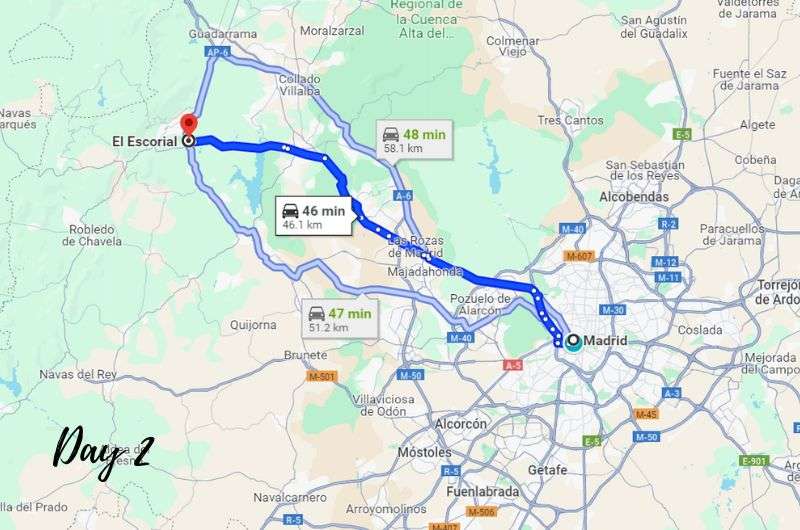
On day 2, you’ll make your way from Barcelona to Madrid and then head straight out for a half-day trip to El Escorial—a sprawling palace
Main site visited on day 2: Train to Madrid, El Escorial Palace outside of Madrid
Hotel recommendations—book for 4 nights: Hard Rock Hotel | Only YOU Hotel Atocha (both ideally located close to Atocha train station)
Further reading: 2-day Madrid itinerary | Best museums in Spain
Today, you’ll hop on a train to Madrid, and then proceed to leave Madrid... because you’ll be visiting the sprawling El Escorial outside of town.
Day 2, stop 1: Train from Barcelona to Madrid
- Trip duration: 2 h 30 minutes for fastest trains
- Train price: EUR 20 for the cheapest up to EUR 60 for busiest trains—buy your ticket as soon as possible for best price!
- Train stations: Leaving from Barcelona Sants and arriving at Madrid Atocha
Your journey on Day 2 kicks off with a comfortable and scenic train ride from Barcelona to Madrid. You'll depart from Barcelona Sants station, the city's main railway hub, which is well-connected to public transit. The high-speed AVE trains operated by Renfe are your best bet.
Trains to Madrid's Puerta de Atocha station run frequently, with the earliest departures around 6:00 am and continuing throughout the day. The journey typically takes 2.5 hours, so depending on how hard it is for you to get out of bed in the morning, you can choose a departure time that suits you—I recommend leaving Madrid between 7:00 am and 9:00 am, getting you to Madrid by mid-morning, perfect for starting your day with plenty of time for exploration.
Once you arrive at Atocha, Madrid's largest and most historic train station, you'll be greeted by a beautiful indoor garden that’s worth a quick look before you head out.
From here, it’s just a short walk to the car rental counters where you can pick up your vehicle for the drive to El Escorial, the first stop on your Madrid itinerary. You can also go check into your hotel before doing any more moving around; it’s just around the corner.
Pro tip: Book your train tickets in advance online to snag the best prices and secure your preferred time. The AVE trains are known for their speed and efficiency, but also for prices that can quickly double or triple at busy times.
Choose your hotel in Madrid wisely
I have two tips for hotels that are so good and so perfectly located that they are impossible to beat: Hard Rock Hotel and Only YOU Hotel Atocha are very close to Atocha station and super convenient to Madrid’s tourist sights and they crushed it with their interior design. They’re both 4* and have parking available.
Day 2, Stop 2: El Escorial
- Distance from Madrid: 1 hour by train or car
- Time spent here: 2–3 hours
- Opening hours: Tuesday to Sunday 10 am–7 pm, closed Mondays
- Price: EUR 14 + EUR 5 for audio guide, or EUR 20 for a guided tour
- Official website: El Escorial website
Next up is a little half-day trip outside of the city. But the destination is anything but little—it’s the grandest palace I’ve ever seen! Think of it as Spain’s answer to Versailles. And, if you’re anything like me, you’ll leave with a newfound (or newly boosted) appreciation for the Habsburgs, the power they wielded, and the legacy they left behind.
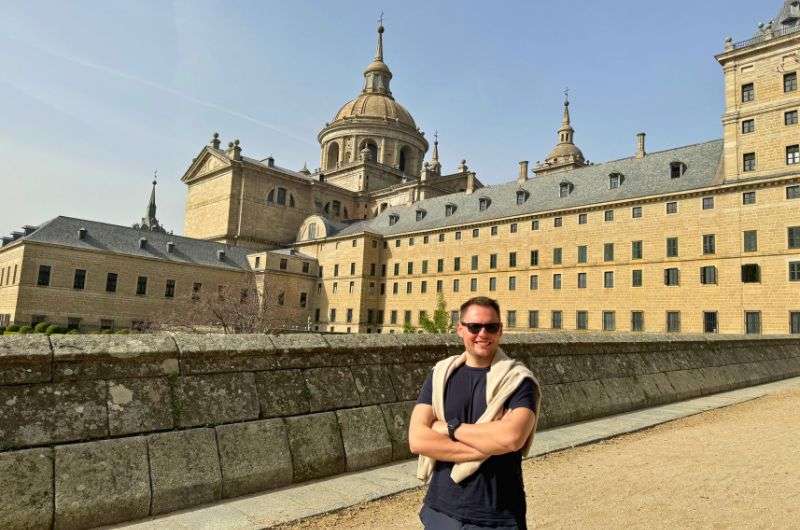
El Escorial
Coming from Madrid, especially when choosing a hotel near Atocha train station, you’ve got a couple of options. Driving will get you there in about an hour, with easy parking available. Or, if you just can’t get enough of the train, you can get to El Escorial straight from Madrid Atocha Station. It’s also about an hour.
Tickets to El Escorial can be bought online or on the spot for EUR 14, an audio guide costs EUR 5 extra. If you want to take it easy and let someone else do the talking, there’s a guided tour option for EUR 20, lasting about 2 hours. I’d go for the tour if you can fully appreciate the historical and architectural significance of El Escorial.
We were there in April and it was smooth sailing and no lines. If you’re visiting during the busy season, it’s worth booking ahead.
Pro tip: Bring a sweater. The basilica is so cold, it could double as a fridge. Trust me, you’ll thank me later when you’re not shivering through your tour.
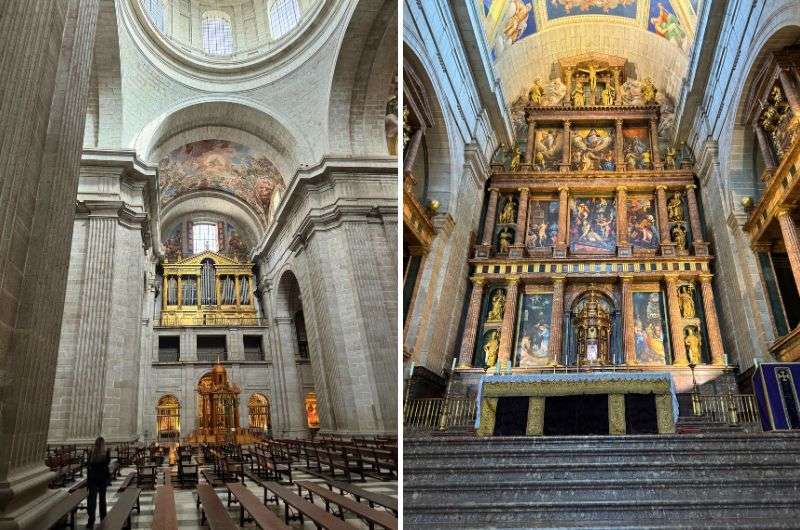
Don’t forget to bring your sweater into the basilica!
El Escorial is a grand historical complex built in the 16th century by King Philip II. It serves as a royal palace, monastery, and mausoleum. When you walk in, you’re hit with this incredible contrast—on the outside, it’s all austere and minimalist, but inside, it’s a different story altogether, just the way I like it. El Escorial was both a royal residence and a religious center, reflecting Philip II's deep Catholic faith and his influence over Spain's empire.
Silla de Felipe detour: A king’s view
Before getting to the palace, you might want to take a little detour to the Silla de Felipe. This was where King Philip II would sit to oversee the construction of his grand masterpiece. The view from up there is stunning—you can see El Escorial laid out beneath you like a tiny model, reminding you of just how powerful Philip was, ruling over a fifth of the world at the time. Mad respect! The hike to Silla de Felipe is about 2 km (1.2 mi) uphill through a beautiful forest, so if you’re up for it, it’s well worth the effort. Just know that on photos, El Escorial might look a bit small due to the distance, but in person, the view is breathtaking.
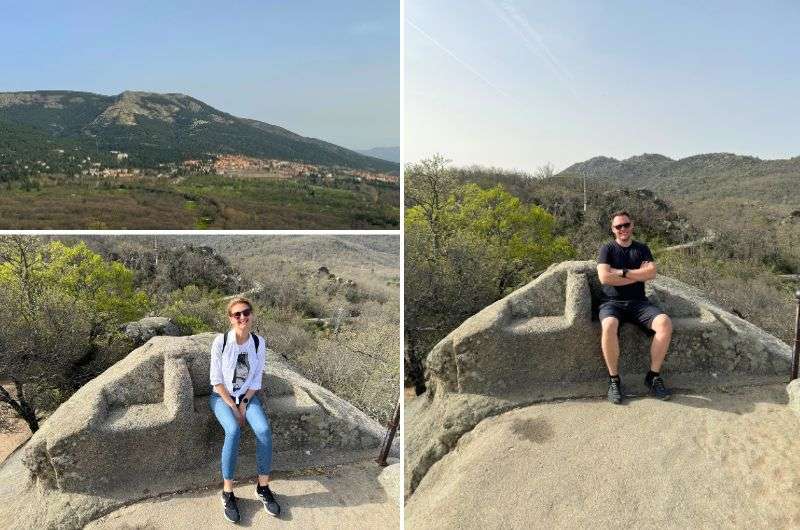
Sit comfortably on Filip's chair and enjoy the view
What’s inside El Escorial
- The Basilica: This place is epic in every sense of the word. The basilica’s sheer size is overwhelming. The altar is massive, covered in golden statues, and the ceilings—just wow. Don’t forget to look up, because the ceilings here are something else. I’d suggest spending a good 20 minutes just soaking it all in.
- Pantheon of the Kings and Pantheon of the Princes: Sure, it’s basically a cemetery, but it’s one of the most beautiful ones you’ll ever see. The entire Spanish dynasty rests here, from Charles V to Philip II. The coffins are incredibly ornate, making this place both morbid and beautiful. Honestly, if I had to pick a mausoleum, this one would do just fine.
- Habsburg Palace: The Habsburg Palace is classic Renaissance, but don’t expect too much in terms of furnishings. Philip II was known for his ascetic lifestyle, so it’s a bit sparse. But even with minimal furniture, the doors alone are so intricately decorated, I’m sure back in the day you could buy a whole house for the cost of just one of those doors. One of my favorite parts was the detailed genealogies of the royal families connected to Spain, which totally feeds my OCD tendencies.
- Hall of Battles: Now, this room is easily one of the most interesting in the entire complex. The walls are covered in murals depicting historical battles, all seamlessly connected in one grand narrative. It’s beautiful and one of my favorite parts of the visit. Unlike some places I’ve been to recently (looking at you, Japan), there’s actually a lot to see inside El Escorial.
- Library: A total feast for the eyes. The library houses thousands of manuscripts, and the frescoes are just stunning. I found myself spending longer than expected here, just admiring the artistry.
- Gardens: After all that history, unwind in the gardens. They’re nicely maintained and offer great views of the surrounding mountains. You can see them in about 10 minutes, making it a quick but peaceful spot to wrap up your visit.
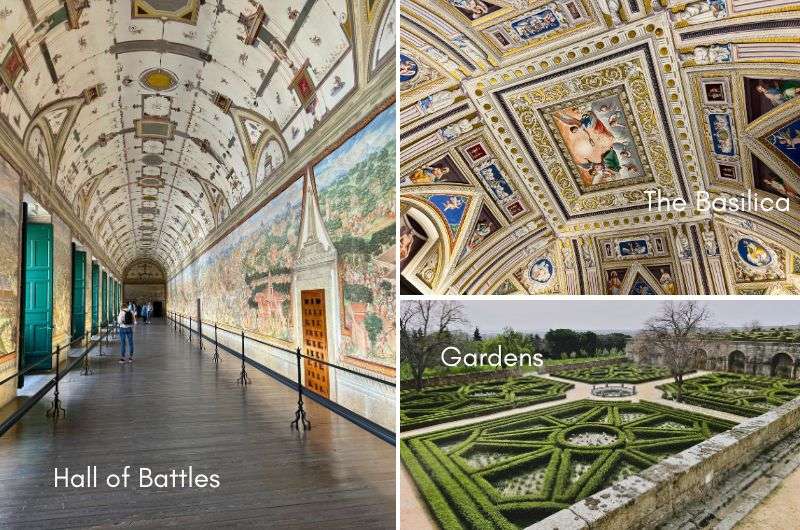
Top things to see in El Escorial
Then, bid farewell to the monster that is El Escorial and get yourself back to Madrid. You should have just enough time to freshen up at your hotel and head out to dinner. Don’t worry if it’s late—this is Spain! Nobody eats before 9 pm anyway! Read up on nightlife in Spain so you know what to expect.
Day 2, Stop 3: Dinner time and Plaza Mayor
To finish your second day in Spain, head to Plaza Mayor, Madrid's main square and a classic stop for anyone passing through the city. It’s one of those places you have to see just because everyone else does, but there’s not really anything to see or do there.
Honestly, it’s a nice enough square, but after all the hype, it’s more “meh” than “wow.” If you’re feeling the need to do something touristy, snap a quick photo with the famous bear and strawberry tree statue, and then head on over for dinner.

Plaza Mayor de Madrid... just a big square
Two restaurants that are nearby and are delicious and with good service are:
- Restaurante Amicis: Meat, fish, burgers, and chill vibes in a cool interior. On a pedestrian street with outdoor seating.
- Restaurante-Coctelería Inclán Brutal Bar: How over-the-top can you go?! With amazing food and great service, the sky is the limit! This place is anything but basic. Sauce in a syringe, anyone?
Day 3 in Spain: Madrid’s highlights and world-famous art
This map shows the highlights of day 3 (you'll want to hop on a metro for some parts). Get it already planned out on Google Maps
Main sites visited on day 3: Royal Palace, Temple of Debod (optional), Almudena Cathedral, The Prado, Royal Botanical Garden, Reina Sofia Museum or Naval Museum
Hotel recommendations—book for 4 nights: Hard Rock Hotel | Only YOU Hotel Atocha (both ideally located close to Atocha train station)
Further reading: 2-day Madrid itinerary | Best museums in Spain
Today, you get to see the best that Madrid has to offer. There are a few optional stops so you can pic and choose, because unfortunately, you only have one full day and you probably won’t fit everything in. Here’s my 2-day Madrid itinerary if you want to consider an extension.
Day 3, Stop 1: Palazzo Real aka the Royal Palace (and optional Temple of Debod)
- Time spent here: 1–2 hours for a tour, 10 minutes if you’re just getting a peek
- Opening hours: Monday to Saturday 10 am–7 pm, Sundays 10 am–4 pm
- Price: EUR 14 for a self-guided tour, EUR 20 for a guided tour
- Official website: Royal Palace of Madrid website
Let’s start with story time: I made it to the Royal Palace, took one look at the line at the ticket desk and decided it wasn’t worth my time. I snapped a selfie, admired the palace from the outside, and called it a day. The end.
Pro tip: Book your tickets online in advance to avoid the epic ticket lines.
Sure, I was let down, but it wasn’t that big of a deal. The building itself is impressive, but nothing too exciting. It reminded me a little of the Buckingham Palace in London… just twice as big. I’m sure it’s a beautiful Baroque palace, but the thought of spending an hour in line just to get inside? Hard pass.
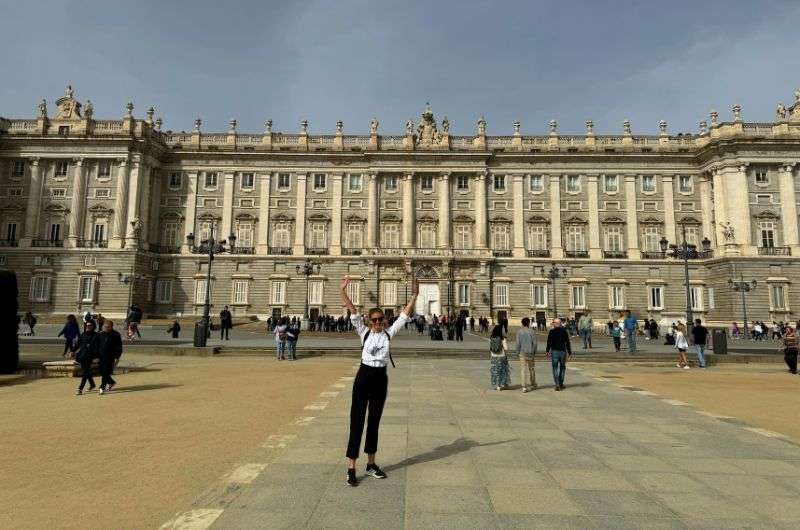
¡Hola! from The Royal Palace
Plus, if you happen to be here on a Wednesday or Saturday from 11 am–2 pm, between June 19 and September 18, you can catch the Changing of the Guard ceremony. Every 30 minutes, you’ll see the sentries on foot switching positions, and every hour, the guards on horseback do the same.
But if you’re more patient, got your tickets in advance, or just really into palaces, here’s what you need to know about the Palacio Real de Madrid: The Royal Palace is the largest functioning royal palace in the world (by floor space, at least) with a whopping 135,000 square meters (or 1.45 million square feet) of floor space and 3,418 rooms. To put that into perspective, that’s about 50 football fields worth of palace. But don’t get too excited—you’ll only see about 20 rooms and a few hallways on the standard tour.
Once you’re inside the Palazzo Real, the crowd moves swiftly from room to room, but yes there are crowds. From what I’ve heard, it isn’t unpleasant once inside though. Maybe there’s something about being surrounded by royal opulence that makes everyone a little more polite!
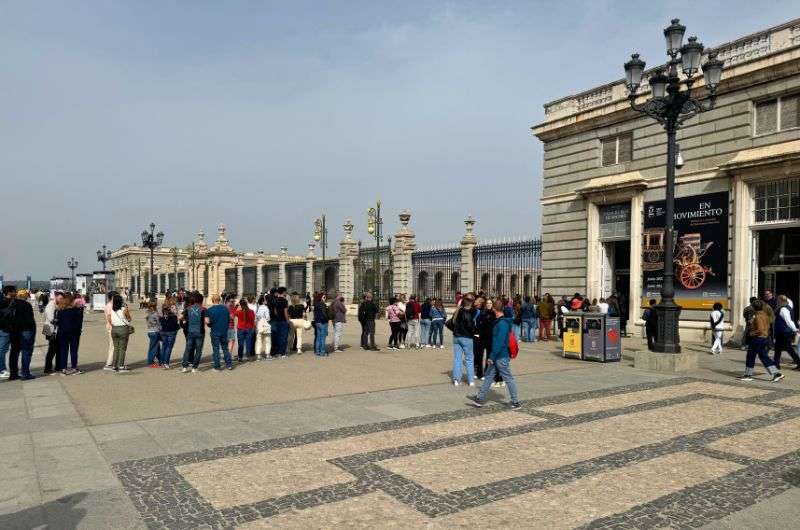
If you want to skip this long line, book your tickets online in advance!
The Royal Armory is a real standout—if you’re into medieval weaponry, this will be your jam. If you’re feeling extra curious, you can pay a bit more for the kitchen tour, but fair warning—some folks have said it feels rushed. Then again, the kitchens are sometimes a surprising highlight (like that time I visited Topkapi Palace in Istanbul), because it gives you a glimpse into the behind-the-scenes of royal life
The chandelier collection here is supposedly next-level. These aren’t your grandma’s chandeliers; these are massive, glittering works of art that light up the already grandiose rooms in the most extravagant way possible. I’m more into minimalism, but kings tend to disagree with me on interior design.
Day 3, Stop 2: Almudena Cathedral
- Distance from Royal Palace: Just a few steps
- Time spent here: 30 minutes
- Opening hours: Monday to Saturday 10 am–2:30 pm, closed Sundays
- Price: EUR 7 (with audio guide on your phone)
- Official website: Almudena Cathedral website
Right next to the Royal Palace is the Almudena Cathedral—it’s neogothic, not just gothic, which gives it a unique vibe. For EUR 7, you can explore the interior, which is worth it just to see how they’ve mixed old and new styles. There’s an audio guide you get on your own phone, one that actually works pretty well compared to other places they’ve offered this.
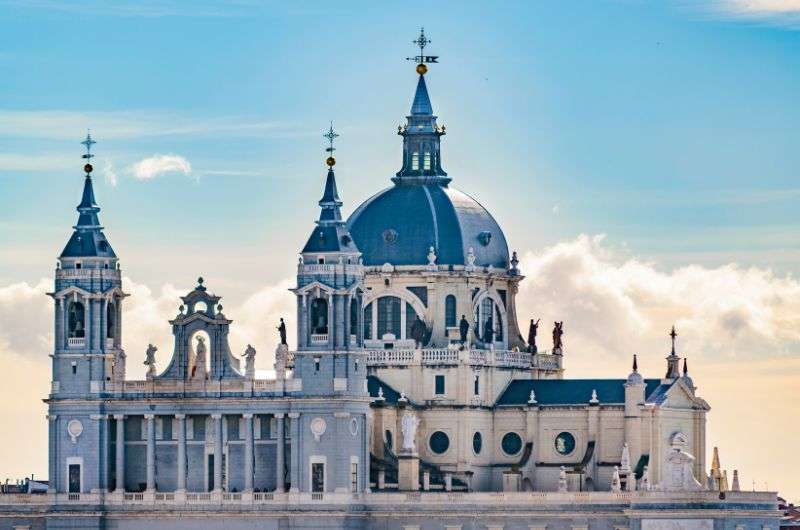
Almudena Cathedral
Inside, the cathedral has some cool modern touches, like the colorful mosaics that break up the otherwise traditional design. And yes, you’ll see everyone ignoring the no-photo rule, which drives me nuts. Just because everyone else is doing it doesn’t mean you should too.
You can also climb up to the dome (or take the elevator if you’re not into stairs aka need to work on your fitness level) and get a great view of the Royal Palace and the surrounding area. It’s a bit of a hike, but the balconies with their raised glass panels make it worth the effort. Note that the viewpoints are closed during the Changing of the Guards at the palace next door.
Optional stop: Temple of Debod
- Time spent here: 30 minutes tops
- Opening hours: Tuesday to Sunday 10 am–7 pm, closed Mondays
- Price: Free
The Temple of Debod is an interesting quick stop if you’re nearby, but it’s not something you need to go out of your way to see. If you want to experience a bit of ancient Egypt in Madrid, it’s a pleasant diversion. Otherwise, you’re not missing much if you skip it.
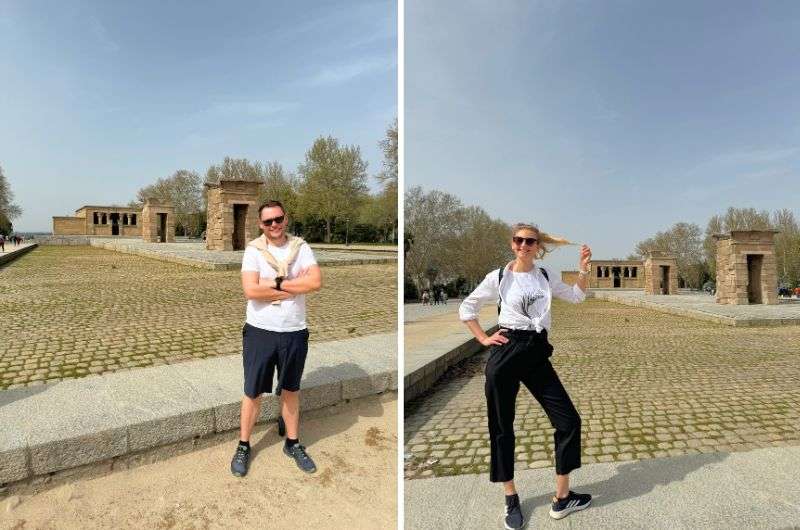
Temple of Debod is not a must see but nice to see (also, not sure where the water went, but the temple is supposed to be sitting on a “lake”)
The Temple of Debod is an ancient Egyptian temple that somehow ended up in the middle of Madrid. Originally built in the 2nd century BCE, it was gifted to Spain by the Egyptian government in 1968 as a thank-you for helping save historic sites from the rising waters of the Aswan Dam.
The temple was originally located near the Nile River, dedicated to the gods Amun and Isis. When the Aswan Dam threatened to submerge it, Spain stepped in to help save several monuments, earning them this impressive thank-you gift.
How did it get to Madrid? The stones of the Temple of Debod were carefully dismantled in Egypt and transported first down the Nile on barges, and then to Valencia in Spain by freighter. Ninety trucks then carried 1,350 boxes of ancient stones from Valencia to their new home in Madrid’s Parque del Oeste, right next to the Royal Palace’s gardens.
While it’s not the biggest temple out there (seriously, it’s small), it’s still an interesting piece of history. You can see everything inside and out in about 30 minutes.
Day 3, Stop 3: Prado Museum
- Distance from last stop: 2.1 km (1.3 mi), a 30-minute walk or take the metro
- Time spent here: 2 hours minimum
- Opening hours: Monday to Saturday 10 am–8 pm, Sundays 10 am–7pm
- Price: EUR 15
- Official website: Prado Museum website
Next, you’ll want to hop on public transportation to get to the Prado efficiently; there’s no time to waste! The Prado is one of the world's most famous art collections, and it's the place where Madrid really shows off. And it’s massive! It’s packed with masterpieces that even someone who usually skims through art museums will appreciate.
If you’re smart, you’ve pre-booked your tickets online, so you can stroll right in while others wait in line for tickets like chumps.
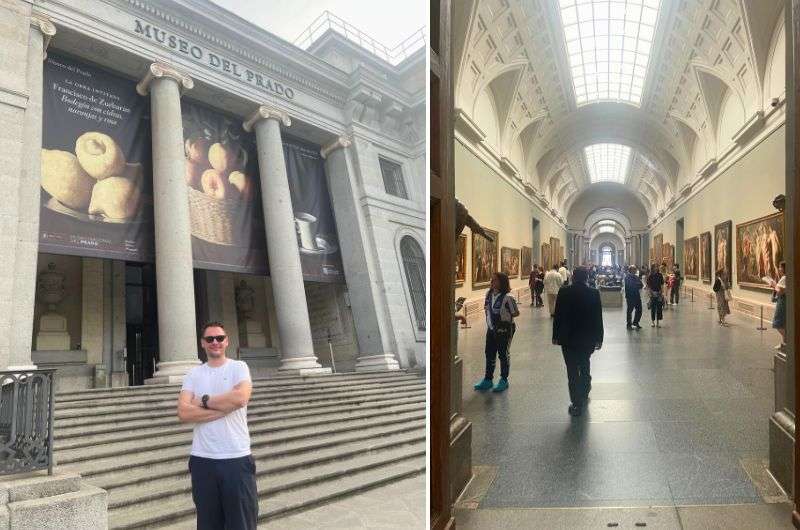
Be ready to spend hours at Museo del Prado
Grab a map at the entrance and focus on the big names. If you try to see everything, you’ll either go insane or grow a beard in the process. The Prado is aware of its own hugeness and has a 2-hour itinerary mapped out for you (and a 1-hour version if you’re a complete art-phobe).
Tip: After an hour or so, you might start experiencing “art fatigue.” That’s the moment when every painting starts blending together, and your brain screams for a break. Fight the urge to rush through by taking a moment to sit and absorb what you've seen. There are cafes in the Prado full of tired tourists just like you.
As you move through the museum, you’ll notice a wild difference in quality between the painters—some are absolute geniuses, while others... well, let’s just say they fill up the space. Velázquez, though, he’s in a league of his own. Las Meninas alone is worth the visit, but his other works are just as impressive. And then there’s Goya, who takes you on a rollercoaster from heroic battles to the darkest, most depressing corners of the human mind. His room might leave you feeling a bit shaken, but that’s what makes it unforgettable.
By the time you get to Bosch’s The Garden of Earthly Delights, you’ll either be fully immersed or questioning your sanity. It’s like a medieval acid trip—pure madness on canvas. And don’t skip Raphael’s Cardinal or Dürer’s self-portrait—they’re like a breath of fresh air after the heavy medieval stuff downstairs.
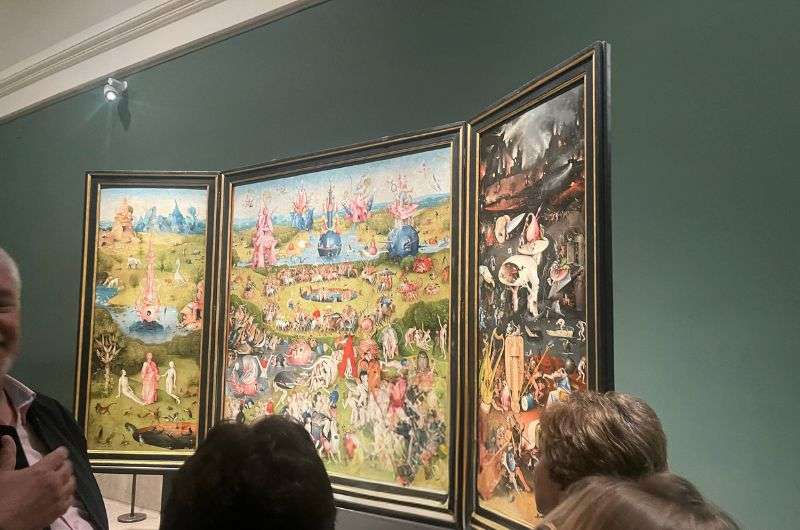
The Garden of Earthly Delights by Hieronymus Bosch
Here are some of the top masterpieces I think you shouldn’t miss at the Prado:
- Las Meninas by Velázquez: This is the Mona Lisa of the Prado. It’s a portrait, but also a behind-the-scenes peek into the Spanish royal court. The painting is famous for its complex perspective and the way Velázquez managed to paint himself into the scene—like the original photo-bomber.
- The Third of May 1808 by Goya: A powerful anti-war painting that shows the brutal reality of the Napoleonic Wars. Goya wasn’t afraid to show the horror, and you can feel the fear and chaos jump off the canvas.
- David with the Head of Goliath by Caravaggio: This is one of the most brutal and beautiful pieces in the Prado. David is holding the freshly chopped head of Goliath, and if you look closely, you’ll notice that Caravaggio used his own face for Goliath. It’s both gorgeously painted and delightfully gruesome.
- The Garden of Earthly Delights by Hieronymus Bosch: This triptych is as bizarre as it is fascinating. It's like looking at the fever dream of a medieval mind—a mix of paradise, earthly pleasures, and hellish scenes all in one.
- Cardinal by Raphael: One of the highlights of the Renaissance section. Raphael’s work here is a masterclass in capturing the subtleties of human expression, and it’s a stark contrast to the more rigid medieval pieces you’ll find on the ground floor.
- Self-Portrait by Dürer: Another must-see, this self-portrait is a prime example of how artists began to view themselves as important subjects in their own right during the Renaissance. Dürer’s confident gaze and meticulous detail make it clear that this guy knew he was a big deal.

More Prado paintings
Fun fact: The Prado's collection is valued at over EUR 10 billion. That’s a lot of zeroes, and it makes you realize why security is so tight. The Prado owns more than 8,000 paintings in its vaults, though only about 1,500 are on display.
After about two hours, you’ll probably hit your limit, which is perfect timing to move on. You've seen enough to have your mind blown without burning out. Now, go get some fresh air.
Day 3, Stop 4: Royal Botanical Garden
- Distance from last stop: Right next to the Prado
- Time spent here: 1 hour max
- Opening hours: Daily 10 am–9 pm (closes earlier in months other than May–August)
- Price: EUR 4
I think by now you’re ready for a breather, right? Luckily, the Royal Botanical Garden is just a few steps from the Prado. You’ll be back in museums shortly, so enjoy the great outdoors while you can. The garden isn’t massive, but that’s part of its charm—you can wander through in less than an hour, taking in everything from desert plants to lush jungle-like greenery. My favorite were the palm tree and the rainforest area.

My girlfriend really enjoyed walking among the plants at Royal Botanical Garden
It’s laid out in neat, easy-to-navigate sections, so even if you’re not a hardcore plant enthusiast, it’s still a pleasant way to spend some time. Or, if you’re really into being surrounded by trees, you could even venture into nearby Retiro Park. It’s like Madrid’s Central Park, but only 1/3 of its size.
Day 3, Stop 5: Reina Sofia Museum or Naval Museum
After immersing yourself in classic art at the Prado, it's time to decide: continue exploring the world of (this time modern) art at the Reina Sofia Museum, or dive (get it?) into Spain's maritime might at the Naval Museum. Here’s a breakdown of both to help you choose:
Option 1: Reina Sofia Museum
So, if you’re still riding the art train after the Prado, the Reina Sofia is where things get… weird. This museum is all about modern art, meaning you’re going to see some pieces that make you question not just the artist's sanity, but maybe your own. The crown jewel here is Picasso’s Guernica—a massive, chaotic masterpiece that smacks you right in the feels. It’s powerful, it’s intense, and it’s worth the visit alone.
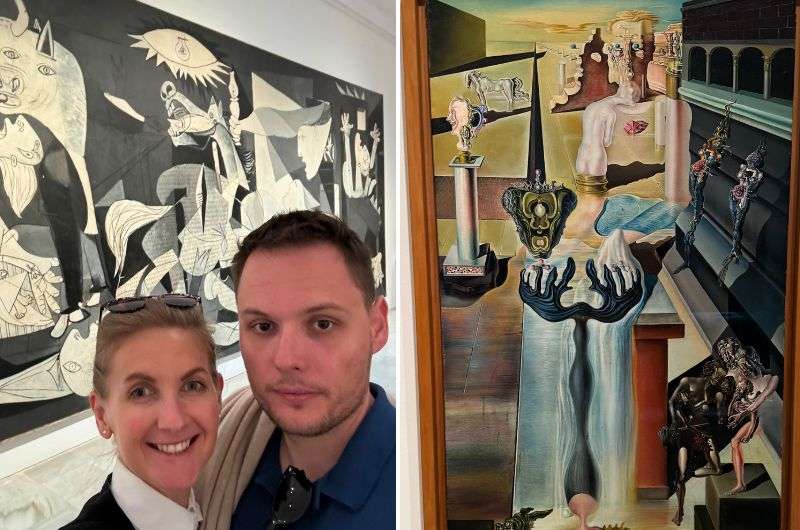
You can tell I was having a bit of an existential crisis with all the crazy art all around me...
I found the sections on fascist and communist art particularly interesting, especially seeing how cubism influenced the propaganda of both sides. It’s not something you see every day, and it adds a whole new layer to the art (especially for history buffs like me).
And then there’s Dalí. His work is scattered throughout the museum, and while his style is closer to what I enjoy, the guy was a bit of a jerk, so I’m always torn. Still, you can’t deny his talent.
Look, modern art can be hit or miss, and the Reina Sofia is no exception. Some pieces will blow your mind, while others might leave you scratching your head. If you think that sounds fun, go for it.
- Distance from last stop: 250 m (0.2 mi), a 3-minute walk
- Time spent here: 1 hour
- Opening hours: Monday + Wednesday–Saturday 10 am–9 pm, closed Tuesdays, Sundays 10 am–2:30 pm
- Price: EUR 12 or EUR 16.50 with audio guide
- Official website: Reina Sofia Museum website
Option 2: Naval Museum
But maybe you’ve had enough of the deep, emotional turmoil expressed through paint (it’s never really the good things in life shown in art, is it?). If that’s the case, head to the Naval Museum and get your dose of Spanish history on the high seas. I, for one, very much enjoyed this museum. This place is a hidden gem, and for a mere EUR 3 “donation”, you get access to some seriously cool exhibits.
Spain ruled the waves back in the day, and this museum showcases that with ship models, ancient maps, and tales of epic naval battles. It’s only one floor, but it’s packed with history, so it’ll probably take you longer to explore than you’d expect. You’ll walk through everything from Spain’s earliest naval escapades to its time as the world’s maritime superpower. I have to admit, this museum was way more interesting than I expected.
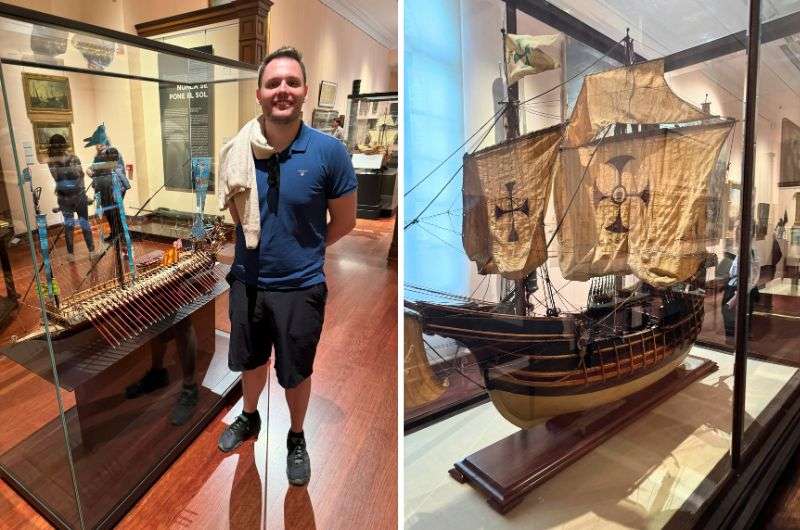
Me in my element at the Naval Museum
The Naval Museum has awesome exhibits on Columbus’s New World voyages, a fascinating 1500 world map showing the Spanish Empire’s reach, and the famous phrase "The Sun Never Sets on the Spanish Empire" is used nicely throughout. It also highlights the epic rivalry with England, including the Spanish Armada’s ill-fated invasion attempt. Boy, do I love these historic battles!
If you’re into history, Madrid’s Naval Museum is a goldmine of stories. Get the audio guide and choose from one of several routes, lasting from 1.5 hours to 2.5 hours.
- Distance from the botanical garden: 750 m (0.5 mi), a 10-minute walk
- Time spent here: 2 hours
- Opening hours: Tuesday to Sunday 10 am–7 pm, closed Mondays
- Price: Officially free but with a EUR 3 recommended donation
- Official website: Madrid Naval Museum website
Dinner time!
And that’s a wrap for your day in Madrid! If you’re wondering where to go for dinner, there are endless options. Seriously, besides the museums, restaurants are what Spain’s capital does best. You could try Tasca Barea, a small “vibey” bar with vermouth on tap and service that’ll make you feel like you’re part of the gang. Or something a little nicer, Vinitus Gran Via Madrid serves great tapas and wine in a trendy interior.
After my most recent trip to Spain, I’m a huge fan of including some day trips outside of Madrid to make your Spain trip complete. Give these spots at least 2 days out of your 10-day Spain itinerary—they are too good to miss! You know how sometimes day trips are just filler in between the highlights? Not Ávila and Segovia. Plus, if you don’t add them, this itinerary will look like an Andalusia itinerary with Barcelona and Madrid thrown in!
Day 4: Ávila, where medieval magic and giant walls meet
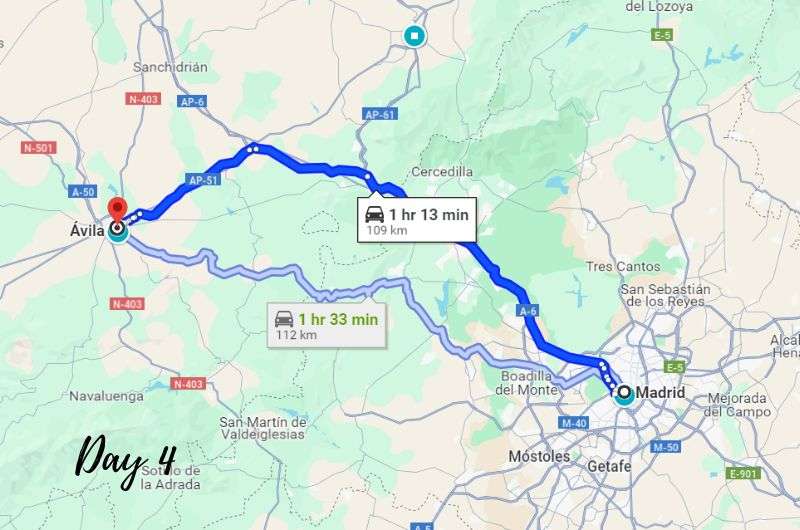
Time for a day trip! Driving to Ávila will be a little faster than the train
Main sites visited on day 4: City walls, Palace of Polentinos, Church and birthplace of Saint Teresa, Ávila Cathedral, Convent of San José Carmelitas Descalzas, Royal Monastery of St. Thomas, Cuatro Postes viewpoint, Monastery of Incarnation, Basilica of St. Vincent
Hotel recommendations: Hard Rock Hotel | Only YOU Hotel Atocha (both ideally located close to Atocha train station)
Further reading: Avila Day Trip Itinerary
Today, you’re heading out for a day trip to a great little city called Ávila, the highest provincial capital in Spain—meaning it’s not as scorchingly hot as Madrid even in the summer.
While you can take a train from Madrid’s Chamartín Station to Ávila, there is no high-speed train, so the journey will take about 1 hour 30 minutes, so you might as well take a car and get there faster. There is ample parking near the city center.
Ávila’s historical center is surrounded by the famous medieval walls, which are well-preserved and a highlight of any visit. The main sights are within walking distance of each other, but some of the more out-of-center locations will require a car to get to comfortably.
Two tips for visiting Ávila:
- Buy a city pass: This pass allows you to enter most of the important city monuments. We found out about it after visiting most of them, so look for it ahead of time. You can even buy Avila Pass online at the cost of EUR 15 per person.
- Take a break: Many of the sights in Ávila are closed between 12 pm–4 pm. Spain and its siesta time, huh? Makes no sense for tourists, but you need to be ready for it at some of Ávila’s tourist spots, too.
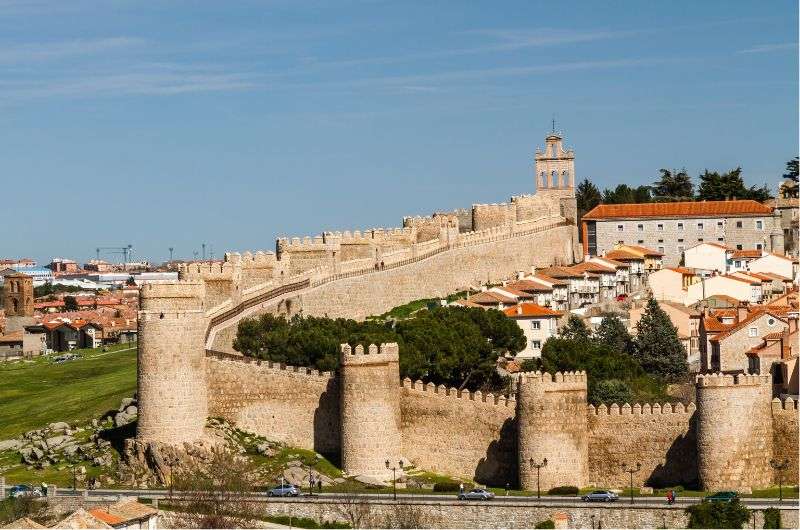
Time for Ávila
Day 4, stop 1: The Walls of Ávila
- Time spent here: 1 hour
- Opening hours: 10 am–5:30 pm
- Price: EUR 5 (free entry until 3:30 pm)
Start your day in Ávila with the famous walls. These are the best-preserved city walls in the world, stretching for about 2,5 km (1.5 mi) with 87 towers and 9 gates.
Start your wall walk at the main entrance behind the cathedral, where you can get an audioguide that takes you through 16 stops along the walls. There are also signs along the walls and close to the gates that provide extra info. It’s easy to see why these walls are a UNESCO World Heritage site.
The walls date back to Roman times and have been meticulously preserved. They’re a fantastic example of medieval fortifications that would protect the medieval town within. Because let’s face it, walls were usually built to protect something, not just sitting randomly in the middle of a field. Storming these walls would have been incredibly tough back in the day!
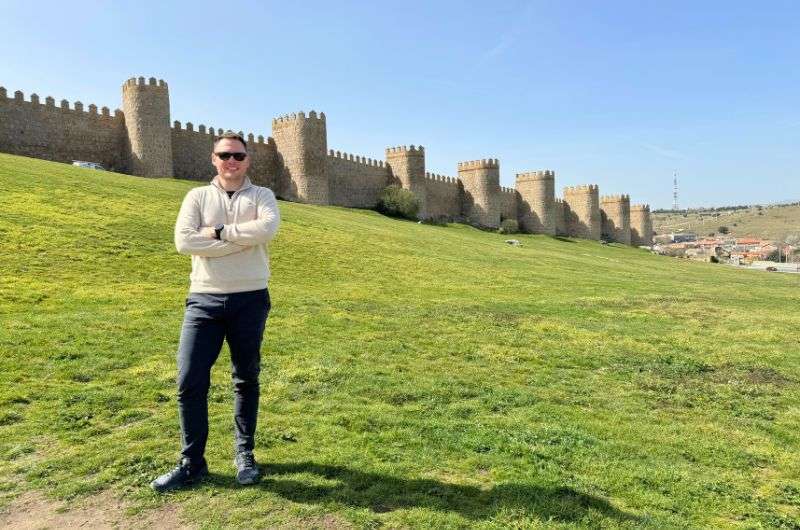
Well-preserved walls from Roman times still unshakably protect the town today (but I have to say I got in just fine)
Pro tip: The walls are particularly stunning at night when they’re lit up—they hold the title for the largest illuminated monument in the world. This is why you get in for free during the day but need to pay EUR 5 after 3:30 pm.
Day 4, stop 2: Palace of Polentinos
- Time spent here: 20 minutes
- Opening hours: 8 am–3 pm
- Price: Free
Walk 5 minutes over to Palacio de Polentinos, which originally served as a military academy and now houses the General Military Archive. From the outside, it might look like just another medieval house, but inside, it offers an enticing peek into Spanish military history. If you know me, you know this is my jam! But no worries even if this isn’t your normal cup of tea—the museum presents history with a fun twist. The interactive exhibits, including some cool VR experiences, make it an engaging visit.
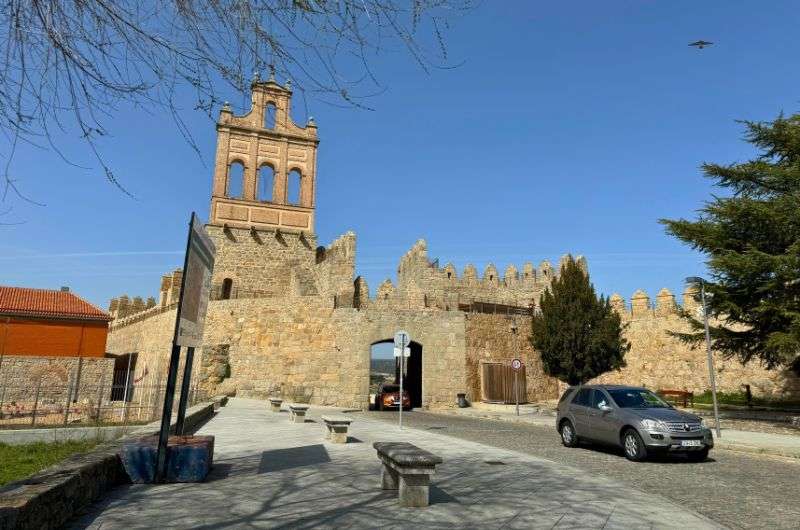
Palace of Palentinos is currently the headquarters of the General Military Archive
The museum is small but packed with artifacts, uniforms, and documents. No tanks or the like, calm down. Despite most of the signage being in Spanish, a little help from Google Translate can go a long way. Or Spanish skills, like I have (yes, that was a flex).
Day 4, stop 3: Church, convent, and birthplace of Saint Teresa (Basilica y casa natal de Santa Teresa)
- Distance from last stop: 500 m (0.3 mi), a 7-minute walk
- Time spent here: 30 minutes
- Opening hours: 10 am–2 pm, 4 pm–7 pm, closed on Mondays
- Price: EUR 3 (cash only)
Next, head over to the Convent and Museum of Saint Teresa. You can only pay with cash here, so make sure you have a few euros on hand. Right from the start, you’re greeted by medieval music, which follows you throughout the tour, setting the perfect ambiance.
There’s a church, convent, and a museum built on the site where Saint Teresa of Ávila was born and lived, experiencing miracles and mystical experiences in this very spot, which adds a sprinkle of historical magic.
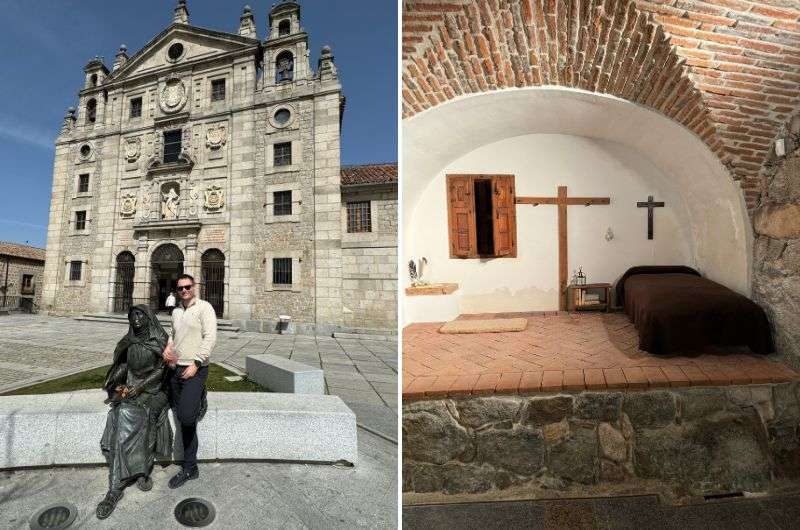
The birthplace of Saint Teresa
Though the guide speaks English, the signs are only in Spanish. So, either brush up on your Spanish or be prepared to use Google Lens. If you’re religious, this place will resonate even more with you—just don’t get your hopes up for any miracles. For the rest of us, it's still a fascinating peek into history (and into how some peoples’ minds work!).
The church building itself might not win any beauty contests, but the historical artifacts make it worth the visit. Plan to spend about 30 minutes here.
Fun fact: Saint Teresa was the first of only 4 women to be named a Doctor of the Church. Many priests from this convent went to the Americas to spread Christianity during the time of the conquest. So, you’re literally standing where history was made.
Now that you’ve filled your quota of historical and slightly eerie sights, let's move on to the next stop!
Day 4, stop 4: Ávila Cathedral + lunch
- Distance from last stop: 600 m (0.4 mi), a 9-minute walk
- Time spent there: 1.5 hours
- Opening hours: 10 am–9 pm (Sundays from 12:30 pm)
- Price: EUR 8 + EUR 3 for the tower
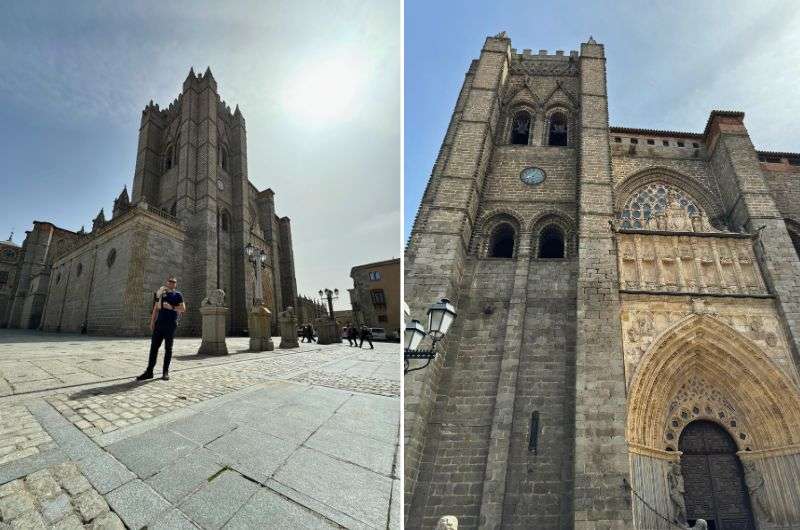
The Cathedral of Ávila
Ávila Cathedral was the first Gothic cathedral in Spain, built in the 12th century. This place is massive and a visual delight. One of the coolest features is that the bricks are exposed, giving it a raw look. I personally loved it.
As you stroll around, you’ll notice that the photography angles here are uncommonly great, so keep your camera ready and snappin’. Check out the impressive limestone wall from the 16th century that looks much newer and of incredible quality. The rear nave, with its brickwork and colors cast by the stained-glass windows, is absolutely stunning, resembling South American cathedrals.
The tourist experience at the Ávila Cathedral is second to none, there are so many things to see and do. Make sure to grab the audio guide (free with your ticket)—it’s packed with fun facts and skips the boring stuff. Look out for the detailed timeline of religious history… I love me a timeline! They’ve also got VR glasses for a stop the end of tour. You get to fly through Ávila and into the cathedral, which is worth putting your hygiene standards aside for (I seriously wished I could wipe those things before putting them on my face!). Kids love it, and let's be honest, so did I. It’s like Universal Studios but holier.
Then there’s a lovely walled garden that’s perfect for a peaceful stroll after all that historical overload. Plan to spend about 90 minutes in the cathedral, which is way longer than your average cathedral tour but you'll really need all that time to see everything.
Lunch in Ávila
Now would be a good time for lunch—a good place to do that would be at Taberna de los Verdugo. I had one of the best steaks ever there. It’s a 3-minute walk from the cathedral. Service is professional and friendly, and the food is divine!
Day 4, stop 5: Convent of San José Carmelitas Descalzas
- Distance from last stop: 700 m (0.4 mi), a 9-minute walk
- Time spent here: 30 minutes
- Opening hours: unclear
- Price: Free
For your next stop on this itinerary, you’re heading to your first stop outside of Ávila’s walls—the Convent of San José, the first convent founded by Saint Teresa in 1562.
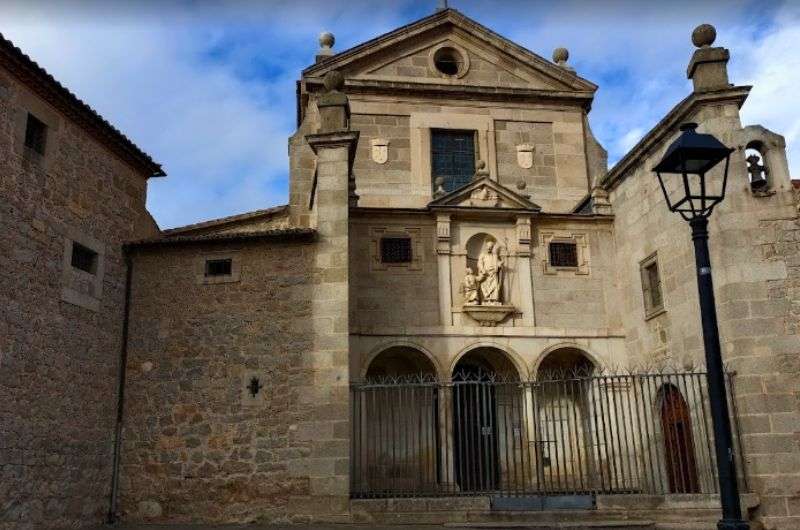
Convento de San José
The convent is known for its simplicity and austerity—think cold, small, and unembellished. The main church, built posthumously in honor of Saint Teresa, is also austere but larger. It holds the only altar dedicated to Saint Joseph in all of Spain. The convent is a cloistered one, meaning the Carmelite nuns live a life of seclusion, devoted to prayer and contemplation. What a life!
Inside the museum, which is located next to the church, you can explore old rooms of the convent, view paintings, sculptures, and various belongings and relics of Saint Teresa. It should give you a better idea of what life is like for a Carmelite nun.
Day 4, stop 6: Royal Monastery of St. Thomas (Monasterio de Santo Tomás)
- Distance from last stop: 700 m (0.4 mi), a 9-minute walk
- Time spent here: 1 hour minimum
- Opening hours: 10:30 am–2 pm and 3:30 pm–7:30 pm (in July and August from 10:30 am – 9 pm with no siesta)
- Price: EUR 4
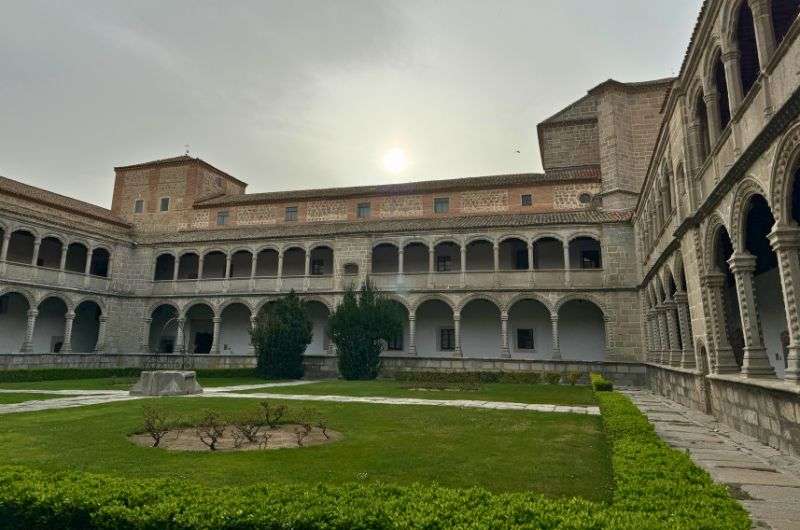
Monasterio de Santo Tomás
A bit further from Ávila’s city center, but worth the trip, is the Royal Monastery of St. Thomas. This is the king’s and queen’s cloister, so you know it’s going to be grand. It’s a significant monastery in Spain, blending Romanesque and Gothic styles, which means it’s super old and super impressive.
There’s plenty of street parking around, so bring your car from this point, you’ll need it for the next stops on the itinerary.
From the outside, it might look a bit plain, but inside, it's a whole different story. The complex is organized around several cloisters and includes a church, a former royal palace, a former university, and a couple of museums. Talk about a multifunctional space!
The entry fee is just EUR 4, audio guide is included (useful, since all the signs inside are only in Spanish). Walking through the monastery, you can almost hear the echoes of monks shuffling through the halls. The church is surprisingly large yet modestly decorated compared to the cathedral, and the gardens are simple as well, but it’s all very beautiful. Many members of Spanish royalty are buried here. The former royal palace within the complex is a glimpse into the lavish lifestyles of the Spanish monarchy.
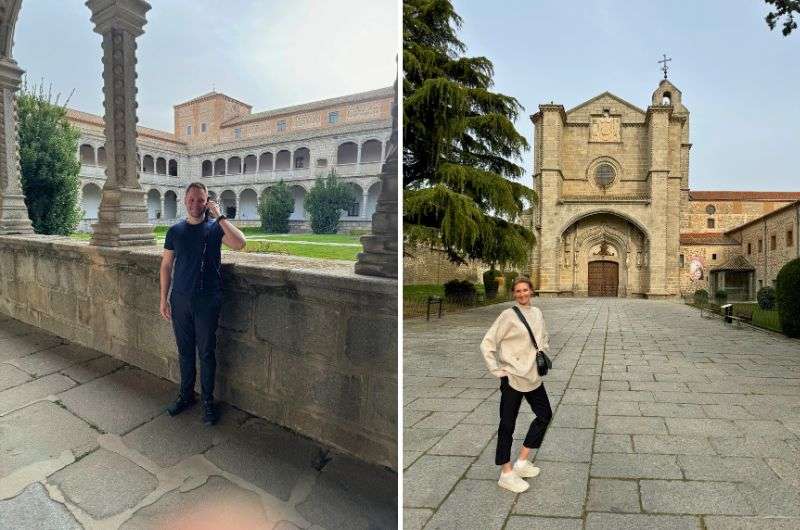
We loved this monastery!
You also get access to the monastery’s fascinating oriental museum and then a museum of natural sciences—this one is a little bit of everything and seems random, is random, but hey, I like museums, so I was happy, though a little confused. The funny thing is that they have more Japanese artifacts here than you might find in some parts of Japan. Go figure!
Take an hour to look around, more if you decide you want to see both museums.
Day 4, stop 7: Cuatro Postes Viewpoint
- Distance from last stop: 2.5 km (2.1 mi), you'll want to drive there
- Time spent here: 20 minutes
- Opening hours: Open 24 hours
- Price: Free
I think you’re ready to take a rest from all the churches and monasteries of Ávila, at least for a little while. Let’s now look at the bigger picture and go get a good look at Ávila from the perfect viewpoint—Cuatro Postes.
There’s adequate parking and informative signs (in English, finally!) make this a must-see, please-the-tourists stop. It’s a popular spot, so expect company, but people are generally respectful about taking turns for the best photo spots. The giant “Ávila” letters are a huge hit for those Instagram moments… who do you think took the better shot?!
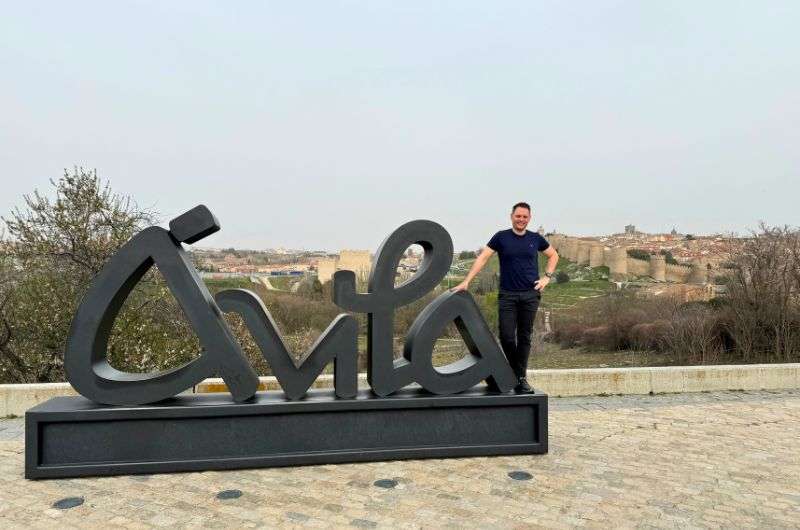
Who did it better: Option number 1 (thank you in advance for all your votes)...
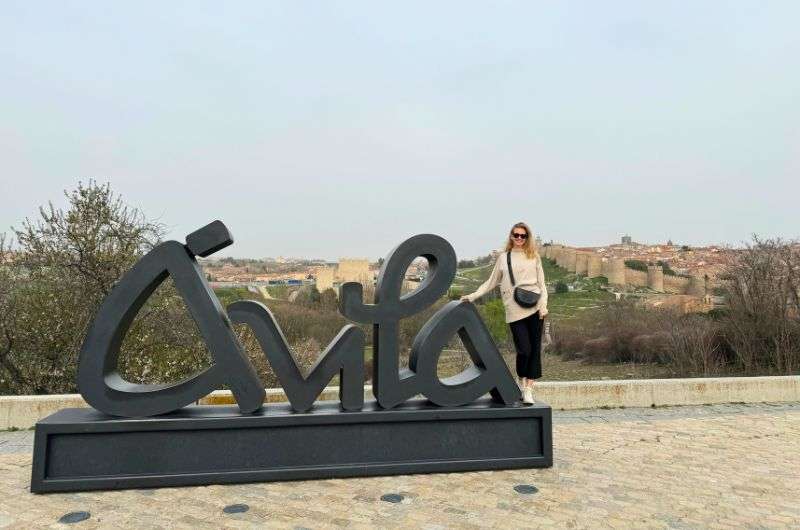
Who did it better: Option number 2
Tip: The sunset views from here are phenomenal. Picture the walled city bathed in golden light, then gradually lighting up as dusk falls. If that doesn’t make you feel all warm and fuzzy inside, I don’t know what will. If
Day 4, stop 8: Monastery of Incarnation
- Distance from last stop: 2 km (1.2 mi), a 3-minute drive
- Time spent here: 30 minutes
- Opening hours: Weekdays 9:30 am–1:30 pm and 4 pm–5:30 pm; on weekends it’s 10 am–1 pm and 4 pm–6 pm)
Are you still up for more religious buildings? I have a monastery and a basilica for you. I recommend going to both, but if you’ve just about had it with the sightseeing, choose the one that sounds more enticing and then head back to Madrid.
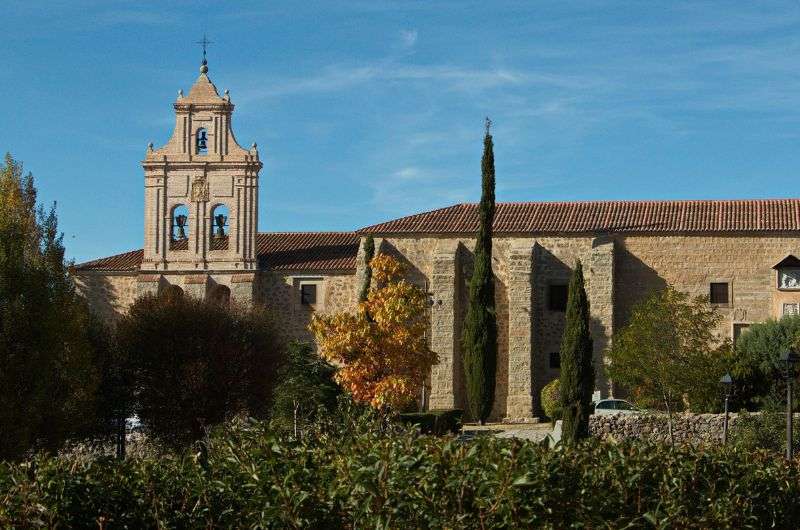
The Monastery of Incarnation
Your first option is the Carmelite Monastery of the Incarnation. This is where Mother Teresa first entered as a nun and lived for almost 40 years. So, even if you feel you’ve seen enough monasteries, you might die of FOMO if you skip this one. You can see where St. Teresa prayed, the room where she and St. John of the Cross would hang out (and levitate, apparently), the place she saw baby Jesus appear, and other significant Teresa-related spots. Don’t miss the small museum for an in-depth look at her life and learn about how she started the reform of all Carmelite monasteries because she hated how it normally worked in them. The patio and garden in front are perfect for a quiet moment of reflection.
For more information and some historical facts about the monastery (and other places I’ve described here), check out my full Ávila itinerary.
Day 4, stop 9: Basilica of St. Vincent
- Distance from last stop: 1 km (0.6 mi), a 15-minute walk
- Time spent here: 20 minutes
- Opening hours: 10 am–1:30 pm and 4 pm–6:30 pm, Sundays 4 pm–6 pm
- Price: EUR 3
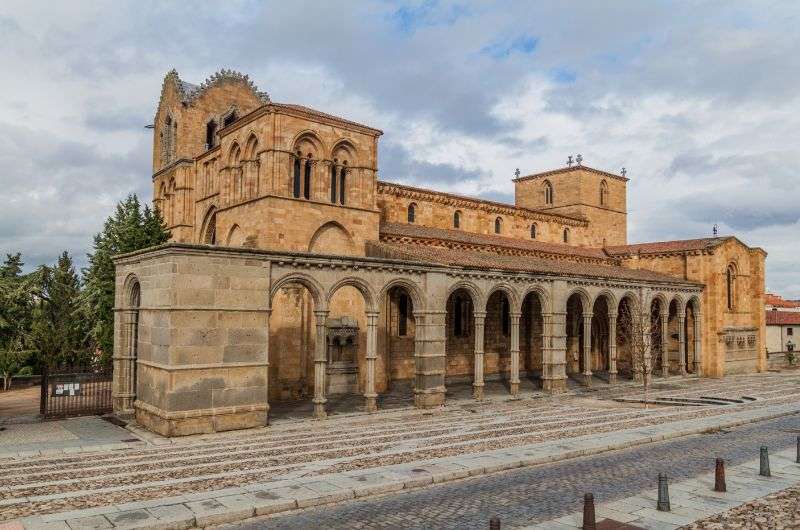
Basílica de los Santos Vicente
Lastly, we have the Basílica de los Santos Vicente, a beautiful Romanesque church from the 12th century. Located near the entrance of Ávila, just outside the city walls, this basilica is a mix of Romanesque style with some Gothic influences.
While the outside might not scream “grand basilica,” step inside, and you’ll be pleasantly surprised. The colorful stones used in its construction make the interior pop. Built on the site where Saints Vincent, Sabina, and Cristeta were martyred, the basilica’s cenotaph is a key highlight with its intricate carvings.
Once you’ve seen it, you can wave bye-bye to Ávila, take one last look at those lit-up walls, and head back to Madrid.
Day 5 in Spain: Segovia: Where fairy tales meet Roman engineering

Another day, another day trip! This time, it makes sense to use the train, which will get you to Segovia in half the time of driving
Main sites visited on day 5: Segovia viewpoints, Sanctuary of Our Lady of Fuencisla, Royal Mint, Plaza Mayor and the Royal Mile, San Martin Church, Casa de los Picos, Roman Aqueduct, Segovia Cathedral, Segovia Alcazar
Hotel recommendations: Hard Rock Hotel | Only YOU Hotel Atocha (both ideally located close to Atocha train station)
Further reading: Best day trips from Madrid | Segovia Guide | Segovia 1-day itinerary
Another day, another day trip that you can do by train or car from Madrid. Segovia is a UNESCO Heritage Site perched on a limestone ridge, which makes it look stunning from the numerous viewpoints outside of the historic center—no wonder the miradores topped by list of the best things to do in Segovia!
The town's most iconic landmark is the Roman aqueduct, an engineering marvel that has stood the test of time for nearly 2,000 years. Then there’s the huge castle and a very nice cathedral that are the highlights of the city. Oh, and the local specialty, roast suckling pig aka cochinillo, is a delight as well.
Segovia is compact and easily walkable. The main sights are clustered together, with the Roman aqueduct at the entrance to the historic center and the Alcázar at the far northern end.
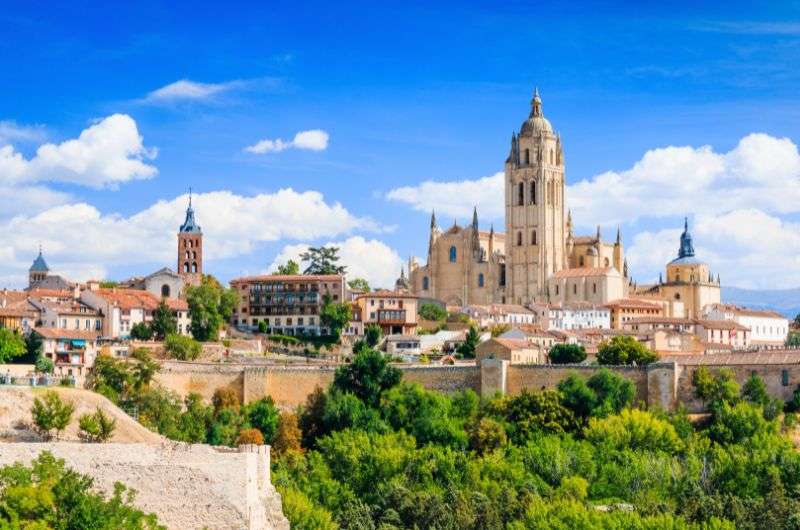
Beautiful Segovia...
Getting there by train is faster, taking a little less than 30 minutes, but unfortunately it doesn’t leave from Madrid Atocha but from Madrid Chamartin, meaning you’ll spend some extra time getting to the train station. Despite this, I still think it makes better sense to take the train.
If you prefer driving, hop in your car for the hour-long journey. Just be ready for complicated and expensive parking in Segovia.
Train station in Segovia
Segovia’s train station is conveniently just south of the city center. A quick taxi or 20-minute walk will get you to the heart of the action.
Day 5, stop 1: All the viewpoints of Segovia
- Time spent here: 60 minutes
- Price: Free
Start your day in Segovia with all the miradores (viewpoints)—it’s the best way to comprehend the grand scale of Segovia and get a proper appreciation of the place. It’s gorgeous, it’s free, and it’s so good I recommend coming back here at the end of the day, because the sunset takes it to another level.
Segovia’s Alcazar (castle) is absolutely spectacular and ginormous and basically makes Segovia what it is. It sits up on a limestone cliff, and you going to the viewpoints gets you front row seats to the show that is Segovia.
All of the viewpoints are located on the northwestern side of the city, so if you’re arriving by train, you’ll want to hop in a taxi to cover the 3.5 m (2 mi). If you’re driving, there’s free parking near the first viewpoint.
Mirador de La Pradera de San Marcos
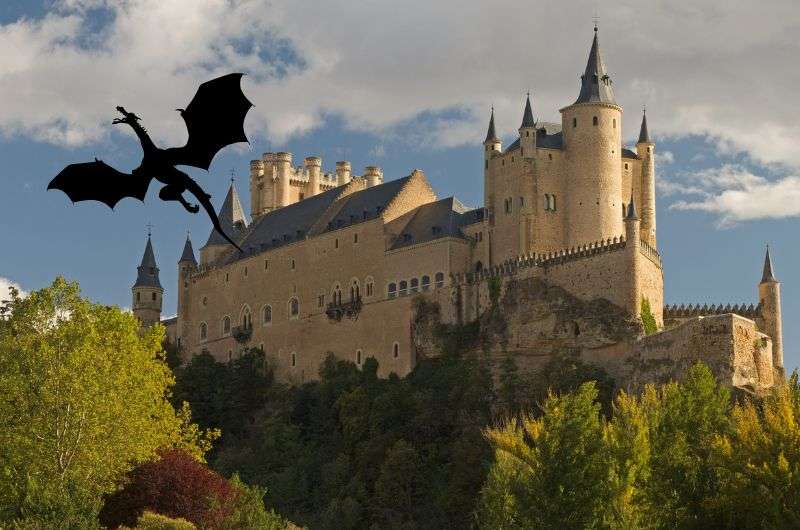
This view has a fairytale vibe!
First up is Mirador de La Pradera de San Marcos and it’s a goodie! I half expected a dragon to fly out when I saw this view.
Mirador de Cristian y Estefi
A stone’s throw away (if you throw uphill) from the first viewpoint is Mirador de Cristian y Estefi. You’ll be rewarded with breathtaking views that make you want to snap a million photos before moving on to the next one.
Mirador de los Dos Valles
Then, continue up to Mirador de los Dos Valles. It’s a five-minute walk from the last viewpoint. The castle looks completely different from this angle—almost like a tower. Note the viewpoint is above the road on a cliff, not right on the road (some people seemed to stop prematurely).
Mirador del Último Pino
The last one is the biggest challenge to get to, but nothing super tough if you aren’t a total couch potato. Mirador del Último Pino is a five-minute stair climb. If you make it up there, expect to be on the same level as the castle where you’ll have earned epic views from yet another angle.
Then, head back down and over to your next stop.
Day 5, stop 2: Sanctuary of Our Lady of Fuencisla
- Distance from last stop: 200 m (0.1 mi), a 3-minute walk
- Time spent here: 30 minutes
- Opening hours: Daily 8 am–8 pm (for the sanctuary)
- Price: Free
Next, climb back down from the viewpoints and make a stop at the Sanctuary of Our Lady of Fuencisla (Santuario de Nuestra Señora de la Fuencisla). It’s a quiet, serene spot with a very golden alter where it seemed very appropriate to keep silencio as there were people deep in thought hanging out with God and whatnot.
What’s really cool is that they actually encourage you to take photos and share them on social media. It's not every day you find a historic church that's all about those Instagram likes!
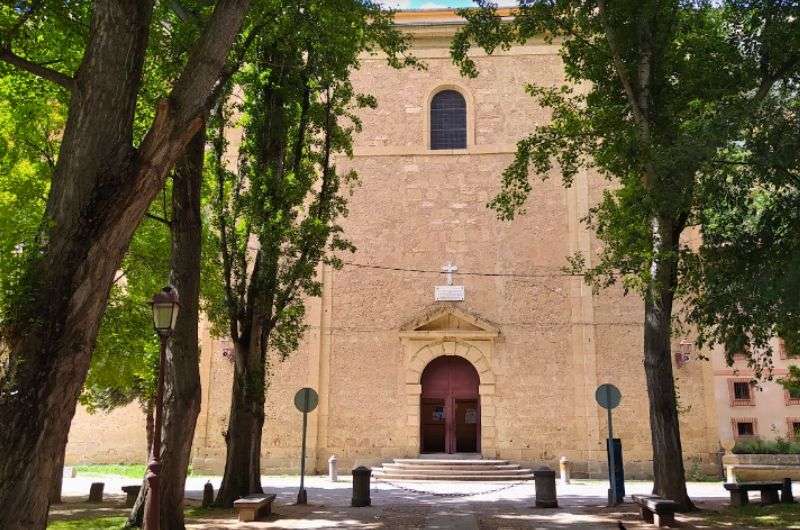
Sanctuary of Our Lady of Fuencisla
You only need a couple of minutes inside, but also take some time to get excited about finally going to explore inside the city walls by checking out the park out front. There are more views of the Alcazar and Cathedral out there, as well as plenty of benches.
And then you’re almost ready to go inside the city. ALMOST.
Day 5, stop 3: The Royal Mint
- Distance from last stop: 800 m (0.5 mi), a 10-minute walk
- Time spent here: 1 hour
- Opening hours: Daily 10 am–2 pm and 4 pm–6 pm, Sundays just 10 am–2 pm
Price: EUR 6
Next, walk to the birthplace of Spanish money—the Royal Mint. This museum is tucked away outside the fortified city walls, in the pretty Eresma Valley, so hopefully you’re still open to more views, because you’ll be getting some!
King Philip II chose the location of the mint in 1583, and he did a brilliant job! By 1588, the building was up and running, making it the first mechanized currency minting factory in Spain.
Walking into the Casa de Moneda, you immediately see that the building is fantastically renovated and has been turned into a great museum with all kinds of interesting exhibits. The museum is modern, with a cool collection and machine recreations that show the entire process from the arrival of the metal to the final coin. You can still see the waterwheels (recreated, not original) and channels that powered the minting machines.
Your ticket also includes the Interpretation Center of the Aqueduct and the King's Garden, so if you get here mid-morning at the latest, you’ll have time to look at those, too.
Day 5, stop 4: Plaza Mayor and the Royal Mile
- Distance from last stop: 1.1 km (0.7 mi), a 20-minute walk
- Time spent here: 10 minutes unless you stop for coffee
- Price: Free
Now it’s time to finally enter the city walls. Don’t be put off by more walking, it’s a very pretty walk that gives meaning to the saying “the journey is the destination”. The main square, Plaza Mayor, isn’t anything that special. It’s a square that happens to be where Segovia’s Cathedral lives, so you’ll finally get an up-close look at it. But don’t go in just yet! We’re building up to it, ok?

Plaza Mayor
For now, just take a wander around the square and keep going to your next stop—the aqueduct. Plaza Mayor is where the “Royal Mile” starts—it’s the main artery of the city’s historic center. It’ll take you all the way to the aqueduct, just follow the crowds. As you walk along the Royal Mile, you'll pass by a slew of significant landmarks, a few of which are worth stopping at…
Day 5, stop 5: San Martin Church (Iglesia de San Martin)
- Distance from last stop: 300 m (0.2 mi), a 4-minute walk
- Time spent here: 10 minutes
- Price: EUR 4 with audio guide
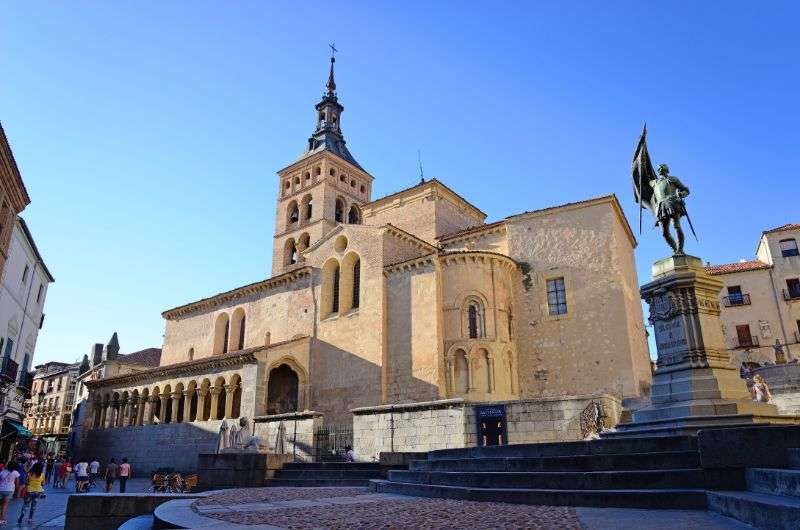
San Martin Church
… like San Martin Church (Iglesia de San Martin). It’s a charming church with a gold altar that’ll make your jaw drop. Built in typical Gothic style, of course. Its exterior is striking, with Romanesque stones and an impressive façade. The tower adds a nice touch.
Your visit will be over in 5-10 minutes, but don’t miss the hilariously short audio guide that comes with the EUR 4 entrance fee.
Day 5, stop 6: Casa de los Picos
- Distance from last stop: 250 km (0.1 mi), a 3-minute walk
- Time spent here: 30 seconds
- Price: Free
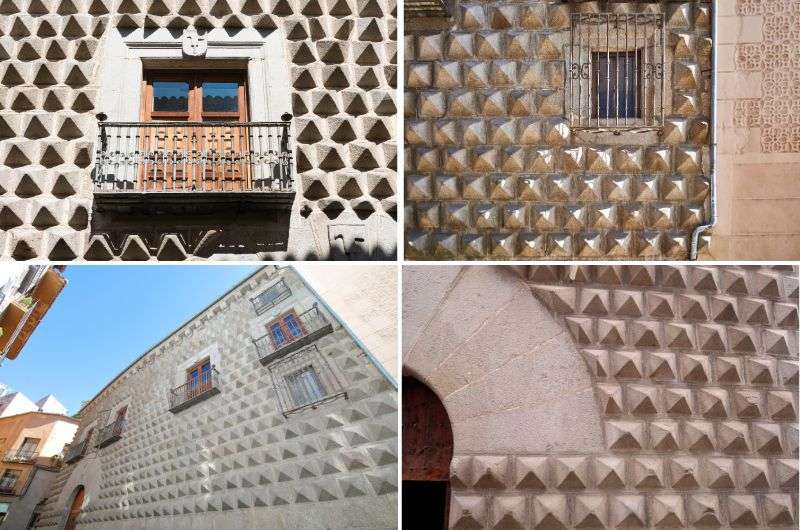
Casa de los Picos
Then, continue walking until you reach Casa de los Picos, which translates to “House of the Pointy Things.” Or something like that. It’s famous for its unique façade, covered in granite points that look like they come from a medieval torture device. And that’s all it is.
It’s a quick 30-second stop for a photo, but not a major attraction, I thought it was just ok. There’s an art school inside, so you really are here to just look at the pointy things.
Say 5, stop 7: Roman Aqueduct
- Distance from last stop: 250 km (0.1 mi), a 3-minute walk
- Time spent here: 1 hour
- Opening hours: It’s right there out in the open, so it’s always visible
- Price: Free
No trip to Segovia could be complete without visiting the Roman Aqueduct. It will blow your mind! The Segovia aqueduct was used to transport water from the Frío River, about 17 km (10.5 mi) away, to the city. It’s composed of roughly 24,000 granite blocks and stands at about 28.5 m (93.5 ft) at its highest point. And it’s huge.
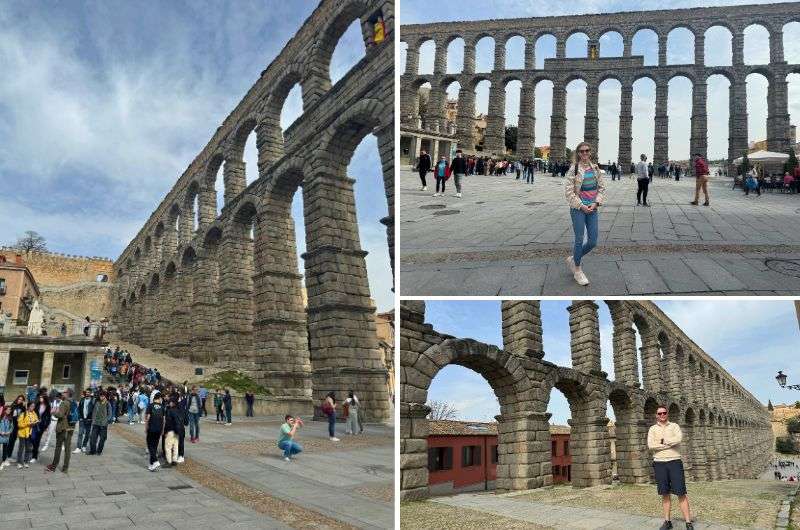
The Roman Aqueduct was still used util the 20th century!
Amazingly, the aqueduct continued to be used for water transportation until the 20th century, serving modern homes and businesses. It was still being used to transport water up until the 20th century (the 70s). Is that ultra cool or what?
Wait until you realize that this thing has been standing here for almost 2,000 years without a single dab of mortar! The stones are perfectly cut to fit together, relying solely on gravity and brilliant engineering. It’s mind-boggling when you consider all the history it’s survived—no invaders, natural disasters, or misguided renovators have managed to knock it down.
The main spot to see the aqueduct from is the square right under it—Plaza del Azoguejo, and then the viewpoint that you get to by walking up the stairs at one end of the plaza.
But I wasn’t happy with just that and decided to walk alongside the aqueduct, searching for the beginning—highly recommended! It felt like I was looking for the beginning of a rainbow, minus the pot of gold. Be ready to walk for quite a bit—20 minutes at a steady pace along the water channel takes you to Inicio de Aqueducto (start of the aqueduct on Google Maps). There you’ll find a small structure marking the beginning. Pretty cool!
Day 5, stop 8: Segovia Cathedral
- Distance from last stop: 400 m (0.3 mi), a 5-minute walk
- Time spent here: 1 hour
- Opening hours: Monday to Saturday 9 am–9:30 pm, Sundays 12:30 pm–9:30 pm, tower tours go several times a day between 10:30 am and 7:30 pm
- Price: EUR 4 + EUR 7 for the tower

The majesty of Segovia Cathedral can't fit in one photo!
If you were impressed by the aqueduct, just wait until you step foot inside Segovia’s Cathedral; full name: Cathedral of Our Lady of the Assumption and of Saint Fructus. So let’s just stick to calling it “the cathedral”. This place is massive, but next to the monumental Alcázar, it actually looks small! In reality, the cathedral spans an impressive 14,025 square meters (151,000 square feet)—so not tiny at all!
You pay EUR 4 for general admission and an extra EUR 7 if you want to include the tower as well. You can buy tickets online in advance, which is a good idea if you want to beat the lines and guarantee you get into the tower. You have to go up with a guide at certain times, so it makes sense to get your time slot prior so you can plan the rest of your day accordingly (especially in busy periods or during holidays). If you get there without a ticket, you could end up waiting way too long for your assigned tower time.
Inside the cathedral, expect Gothic everything: high vaulted ceilings, stained glass windows, and about a million sacristies (okay, maybe not literally, but it felt like it), art, and life-size statues.
It makes sense to get the audio guide if you aren’t on a guided tour and don’t want to be just cluelessly walking around without any context—there’s next to no information inside the cathedral.
Once it’s your turn to go up the tower, remember you can't access it without a guide, so you will be in a group, climbing close to 200 stairs on a spiral staircase. Expect huffing and puffing (not from you, you’re in shape, right?!). Luckily for those with a little less stamina, there are 2 stops on your way up where you will learn about the bell ringer (you even get to peak into his “house“). I have to say, a bell ringer’s job was not easy! Inside the tower, there is a fascinating interactive video and audio guide with interesting facts (the human guide is just a babysitter at this point). The views from the top are simply spectacular, giving you a panoramic look at the city and beyond. The bells up there were made as early as 1480.
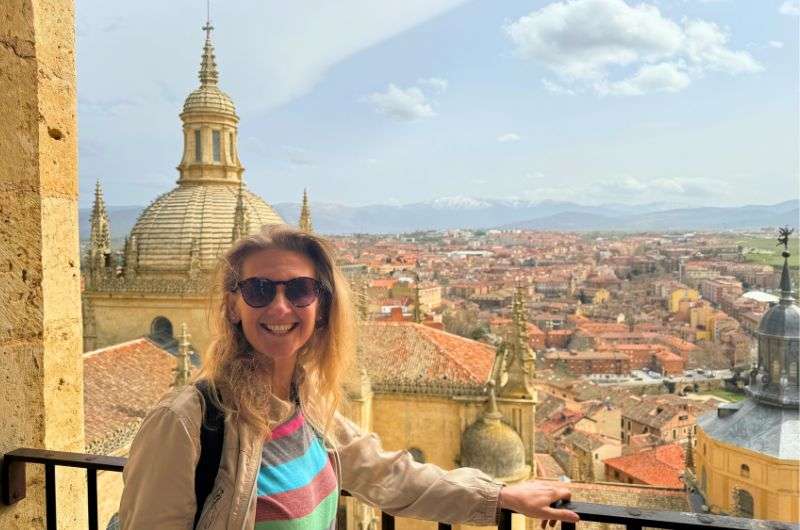
From the tower of Segovia Cathedral you can enjoy beautiful views of the city
The tower originally stood at 108 m (354 ft) and was the tallest building in Spain at the time of its construction. However, after a fire in the 17th century destroyed the tip of the tower (with its mahogany spire), its height was slashed to 88 m (289 ft) and the spire is now made out of stone.
Day 5, stop 9: Segovia Castle (Alcazar)
- Distance from last stop: 650 m (0.4 mi), a 10-minute walk
- Time spent here: 1 hour
- Opening hours: Daily 10 am–8 pm
- Price: EUR 7 without the tower, EUR 10 including the tower (museum included in both)
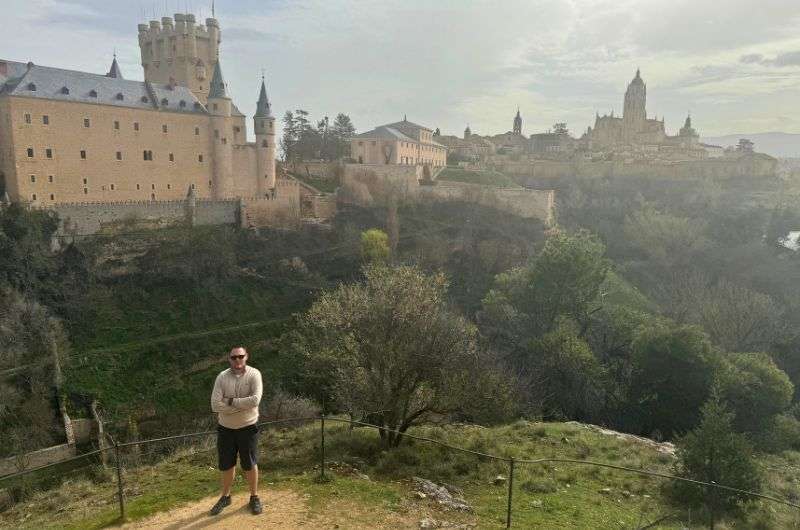
Next up, the monument that comes to mind when you think of Segovia—the famous castle
I want to say that I’ve saved the best for last so you can end your day in Segovia with a bang, but in reality, I felt that Segovia Castle was more awe-inspiring from the outside than it is on the inside. So, when you go in, just remember the WOW! you felt when seeing it from the outside to tide you over some of the more boring bits. Let’s say it was good with some great parts.
Buy your tickets at the ticket desk, which is in Casa de la Química, next to the fortress. If it’s the weekend, I’d get them online in advance just to beat the line (there is a small discount if you do). They sell them at 30-minute time increments to manage crowds inside the castle. Buying tickets in advance also guarantees you the chance to walk up the tower, which gets sold out on busy days.
Tip: Be sure to turn around as you approach the castle, you’ll be getting some great cathedral photo ops!
One fact you can’t miss is that this place is enormous. This fortress has served as a royal palace, military academy, and even a state prison. And the Spaniards nailed it by turning it into a military museum instead of stuffing it with random rococo fireplaces. Trust me, every kid’s (and adult kid’s) dream is a castle full of ancient weapons, not delicate porcelain.
The exhibits are entirely in Spanish, but don’t worry, there’s an audio guide you get on your cell phone that speaks English.
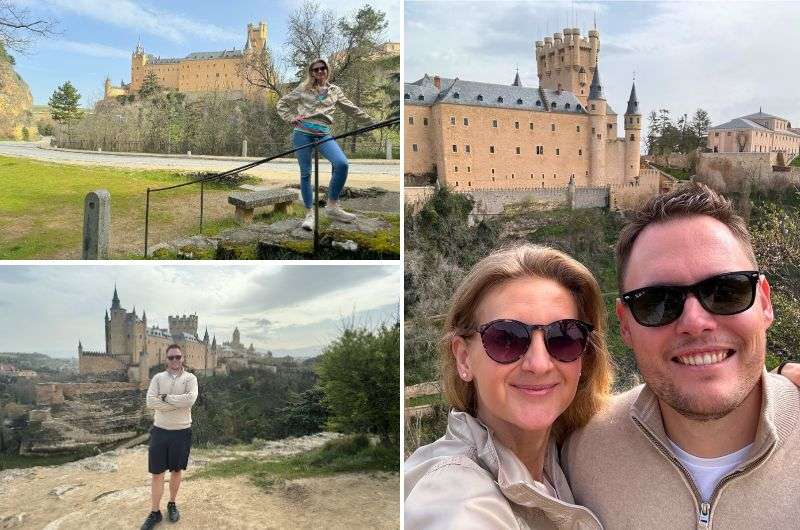
You’ll leave with a ton of pictures from the Alcázar!
The museum is packed with weaponry from the 15th and 16th centuries—late medieval and early Renaissance periods. The museum’s focus on artillery and its influence on science is something I never thought about before, but it’s fascinating.
One of the best parts of visiting the Alcázar is the walk along the ramparts. The views of the surrounding countryside and the city are amazing.
The spiral staircase up to the tower is a head-spinning 150+ stairs, but the views (yes, more views!) are worth it.
Day 5, stop 10: Eat cochinillo, a local delicacy
No Segovia visit would be complete without trying the local delicacy, cochinillo aka roasted suckling pig. It’s as bad as it sounds, and soooo delicious!
We ate ours at José María Restaurant, a Michelin-starred restaurant located close to Plaza Mayor. It’s a traditional place that is famous for its three-week-old suckling pigs.
This dish is a Segovian specialty and is available in other restaurants, but José María is arguably the most renowned. Plus, it’s not as expensive as you might think. For EUR 30, you get a sixth of a piglet, which is plenty to stuff your belly. Service was ok, not spectacular, but the food was to die for.

I treated myself to a Segovia cochinillo for my birthday (actually, it was my girlfriend’s idea)
Make sure you book your table—either on their website if booking further in advance, or by email or phone if booking less than 2 days before your visit.
We had our piglet for lunch and almost rolled out of the restaurant with zero ambition to eat until the next day. So, pro tip: Have cochinillo for dinner, not lunch!
Then, huff and puff back to your car/to the train station, and get yourself back to Madrid. Pack your bags, your Spain itinerary for 10 days is halfway over, so it’s time to head south tomorrow for a look at a very special part of the country, Andalusia.
Day 6 in Spain: Cordoba (and a bit of Sevilla). Ready or not, Andalusia!

Thank goodness for high-speed trains! Today, you’ll cover a lot of ground in not so much time
Main sites visited on day 6: Cordoba’s Mosque Cathedra aka Mezquita, Cordoba’s Roman bridge and the Jewish Quarter, Sevilla’s Plaza de España
Hotel recommendations: Melia Sevilla (book for 2 nights)
Restaurant tips: In Cordoba: Mercado Victoria | Casa Pepe de La Judería | In Sevilla: Cañabota | Az-Zait
Further reading: Cordoba Guide | Sevilla Guide | Sevilla itinerary
You only have 10 days in Spain (if you’re having second thoughts, look at my 2 weeks in Spain itinerary instead), it’s time to bid farewell to the north and book it to the south. This is where Spain’s high-speed trains come in very handy.
Tip: I have a separate 10-day Andalusia itinerary, too. It focuses just on southern Spain and ignores the rest of the country.
Before you base yourself in my favorite Andalusian city, Sevilla, make a stop in Cordoba—home of the Mezquita, a mosque-cathedral that is one of the most impressive monuments in the world (or so they say).
Getting from Madrid to Cordoba
The high-speed train can get you from Madrid Atocha to Córdoba in about 2 hours, costing anywhere from EUR 16 to EUR 60. So again, the sooner you shop, the higher chance you have of getting a good price.
Day 6, stop 1: Cordoba’s Mosque Cathedra aka Mezquita
- Distance from train station: 1.7 km (1.1 mi), a 23-minute walk
- Time spent here: 1 hour
- Opening hours: Daily 10 am–7 pm, the bell tower tour goes every 30 minutes between 9:30 am and 2:30 pm
- Price: EUR 13 + EUR 3 for the bell tower
Called mezquita for short, the mosque was first built in the 8th century by the Moors and was the second-largest mosque of its day. After the Christian reconquest in the 13th century, the mosque was converted into a cathedral with almost no alterations. They threw out the Quran, added a Bible and called it a day. As for the minaret, they chucked the muezzin and added a bell to make a church tower. Work smarter, not harder, right?
It wasn’t until 300 years later that they added the nave and transept, merging two completely different sacral buildings into one. The original mosque part is low ceilings, lots of columns and red and white stripes. The church part is very much a church that happened to land in the middle of a mosque. It’s wild to see that this is what they came up with.
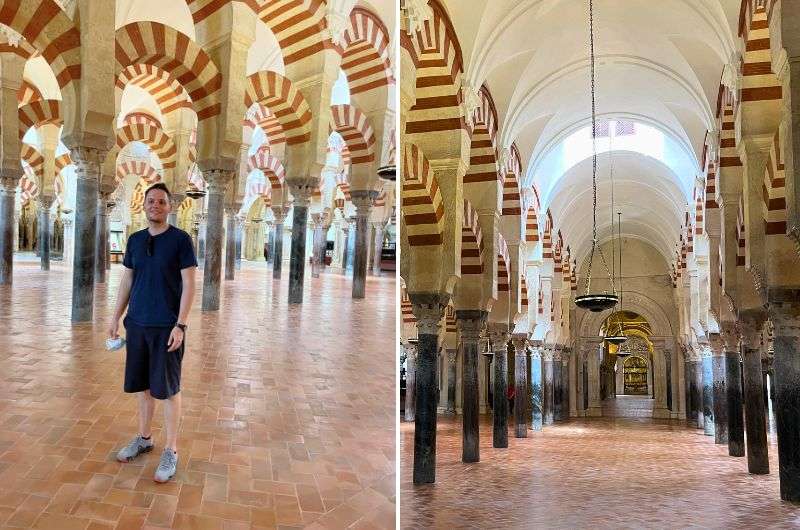
This Cordoba jewel is not to be missed
The Mezquita is Córdoba’s crown jewel, and you’ll see why the moment you step inside. Those iconic red-and-white arches are absolutely worth the hype. But you don’t need more than an hour to take it all in. It’s a quick hit of architectural fun, and then you’re good to go.
You can visit the Mezquita and the bell tower separately. For me, the bell tower was the absolute top thing to see, while the Mesquita itself was slightly underwhelming. Maybe it’s because it doesn’t look very interesting from the outside.
Tickets can be bought on site or online. For the bell tower, since you go in as part of a group at a certain time, I recommend booking your time slot beforehand. For the Mezquita, it’s easy to just show up and buy a ticket at the ticket desk.
Day 6, stop 2: The bridge and the Jewish Quarter
- Time spent here: 1.5 hours
Continue your half-day in Cordoba by wandering the narrow streets of the Old Town and the Jewish Quarter (Judería)—the area around the Mosque Cathedral. Notice the many small courtyards (patios) that Cordoba is also famous for.
Tip: If you’re in town in the first half of May, you’ll be able to take part in the annual Festival of the Patios, which is when Cordoba is tearing at the seams with way too many visitors.
One of the notable streets in the Old Town is Calleja de las Flores, which not only has little nooks and patios, but also an abundance of flower decorating just about every square cm.
The synagogue is free to visit, though it’s only one small room and will take you about 30 seconds to see.
In front of the Mesquita is the Roman Bridge, an old stone bridge that gives you nice views to the city (especially from the opposite shore so the bridge is in your photos, too).
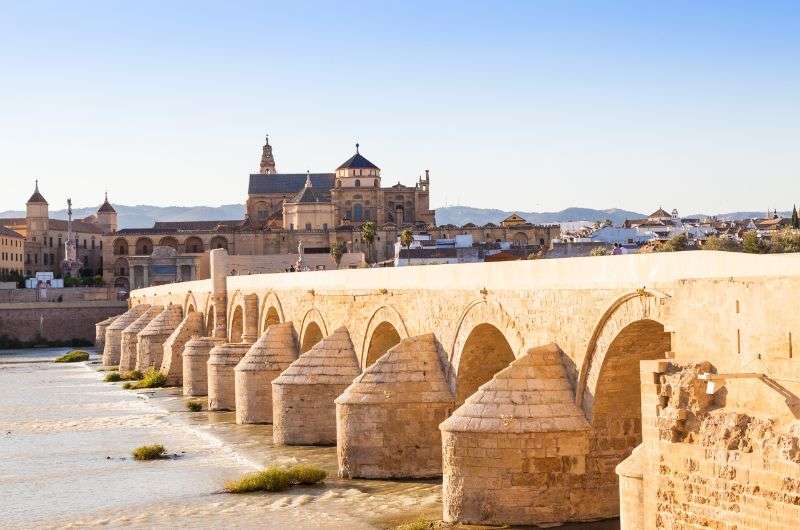
The Roman Bridge
If you are enchanted by Cordoba and want to see more of its highlights, read my Cordoba guide. But I’m afraid you won’t have much more time on this Spain itinerary for 10 days. Don’t be too sad, tough, you’re in for a real treat in Sevilla!
Day 6, stop 3: Train to Sevilla
After you’re done in Cordoba, get yourself back to the train station; Sevilla is another 1 hour away. You’ll want to aim for a train time in mid-afternoon so you can still see a little bit of Sevilla when you get there.
Then, go and check into your hotel so you can wash away the sweat. Which hotel? This one:
Your hotel in Sevilla
My hotel recommendation for Sevilla is the 4-star Melia Sevilla, because it pulls out all the stops without being insultingly expensive.
You can ask for a room with a balcony facing the Plaza de España, or, if you do want to make your stay insultingly expensive, there is “The Level”, where you high ballers can congregate amongst yourselves.
Last but not least, the breakfast is superb. For all levels.
Day 6, stop 4: Plaza de España
- Time spent here: as long as you want before hitting the sack
- Price: free
End your day at the incredible Plaza de España and the Parque de María Luisa.
The Plaza de España was the central, half-circle Andalusia pavilion and main focal point of the 1929 Ibero-American Exposition. Now it’s just there to wow you and to provide offices for the government. But you’re here for the wowing, obviously.
Around the plaza there are tiled alcoves, each of which represents a different region in Spain, a canal where you can rent row boats, a fountain and several other buildings that served as Spain expositions.
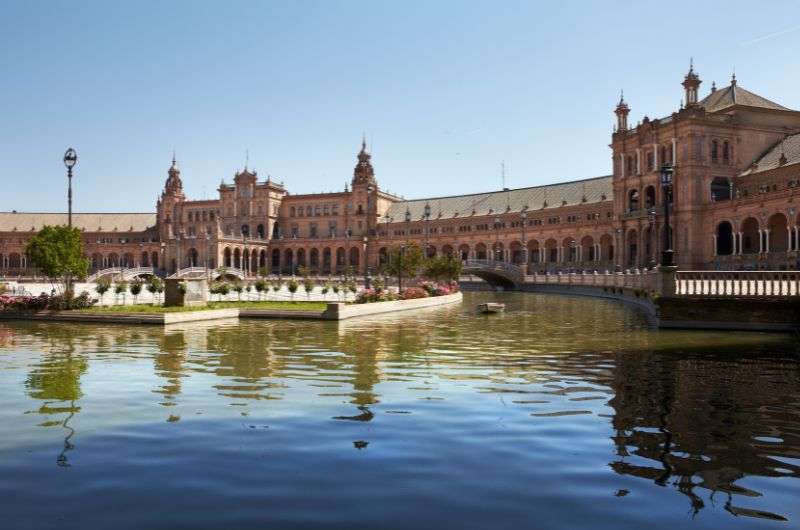
Plaza de España
For me, it’s one of the most monumental places in all of Spain... but it’s still worth only about 30 minutes of your time to really see it; the rest is just bonus time for people watching, which, especially in the evenings, can be a wonderful way to soak in the atmosphere in Sevilla.
There are frequent shows around the plaza. When we visited, there was a flamenco dancer stomping on the 2nd floor of Plaza building, so just roam around and see what you can find. It’s a really pretty place.
Day 7 in Spain: Sevilla, the heartbeat of Andalusia
This map shows the highlights of day 7, though you can choose between the two museums. The star shows Plaza de Espana, which you would’ve seen last night. Get the route planned out on Google Maps
Main sites visited on day 7: The Royal Alcazar of Sevilla, Jewish Quarter, Sevilla Cathedral and La Giralda Bell Tower, Flamenco Museum (or tile museum), Sevilla’s Mushrooms aka Setas de Sevilla
Hotel recommendations: Melia Sevilla
Restaurant tips: Cañabota | Toby eats the world | Az-Zait | La Brunilda
Further reading: Sevilla 2-day itinerary | Sevilla Guide
You’ve got a full day in Sevilla today, lucky you! I mean, I prefer at least 2 days in Sevilla, but time is not your friend on this trip, so here’s how to make the most of it.
You’ll also want to pick up a rental car today (or early tomorrow morning) so you’re ready to zoom off to Granada tomorrow morning.
Day 7, stop 1: The Royal Alcazar of Sevilla
- Time spent here: 3 hours
- Opening hours:
- Price: From EUR 33.80
Sevilla's Alcazar, the best Moorish palace in Andalusia (says me), is where you'll often find me shedding tears of joy in every nook and cranny (kidding, but just barely!). You’ll need to skip a few of the details so you’re not spending half of the day at the palace, but even a slightly swifter visit will take you 3 hours, easy.
The interior is like a labyrinth of tiles and gold, and the gardens are so immaculate they make your garden at home look like a little weed patch.
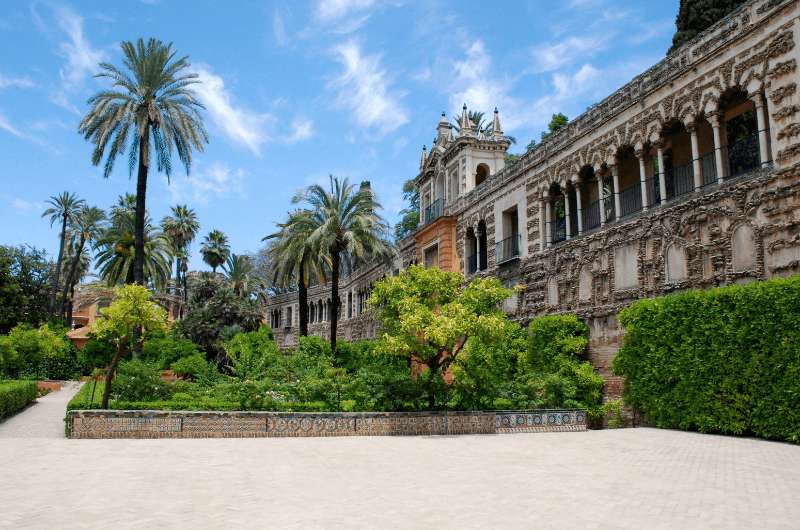
The Royal Alcazar of Seville
The Alcazar is the oldest royal palace still in use in Europe today, and when the Spanish royal family is in town, they stay in the upper stories of the palace. But fear not, commoners! You too can visit their apartments and even the bedroom if you're feeling nosy.
Tickets to Sevilla’s Alcazar
To avoid long lines, buy your tickets online in advance. General admission costs EUR 33.80, and gets more expensive if you prefer a real human guide over an audio guide. Keep in mind that the Alcázar can get pretty crowded, especially during peak tourist season, so aim to visit early in the morning.
Highlights of the Alcazar
- Courtyard of the Maidens (Patio de las Doncellas): This courtyard is the crown jewel of the Alcázar, with its reflecting pool, intricate arches, and stunning tile work. Legend has it that this courtyard was named after the tribute of 100 virgins demanded by the Moors from the Christian kingdoms. Every corner here is a feast for the eyes.
- Princess Baths (Baños de Doña María de Padilla): These underground baths are named after the mistress of King Pedro I and offer a cool, serene escape from the bustling palace above. The arches and reflection of the water create a tranquil atmosphere, making this one of the most unique spots in the Alcazar.
- Ambassador's Hall (Salón de los Embajadores): This is where the kings of Spain once received their most important guests, and it’s as grand as you’d expect. The hall is dominated by a spectacular golden dome, symbolizing the universe, and the intricate tile work and carvings are some of the finest examples of Mudejar art in the world.
- The Gardens: Sprawling across several hectares, the Alcázar’s gardens are a paradise of fountains, ponds, and orange trees. It’s a perfect spot to relax and escape the heat. You’ll find peacocks wandering around, adding to the royal vibe.
- Casa de Contratación: This was where the trade between Spain and the New World was controlled. The room is filled with history and is a must-see for history buffs interested in Spain's colonial past.
Fun Fact: The Alcázar has been featured in numerous films and TV shows, including Game of Thrones, where it stood in for the Water Gardens of Dorne. So, if you’re a fan, you’ll recognize some familiar spots.
Details about visiting the Alcazar are in my full Sevilla article.
Day 7, stop 2: Sevilla’s Jewish Quarter
- Distance from last stop: Just outside the front gate of the Alcazar
- Time spent here: 1 hour
- Price: free
The little cobblestoned streets in front of the Alcazar make up Sevilla’s Jewish Quarter (Barrio de Santa Cruz), where you'll feel as if you've time-traveled back to the Middle Ages.
The walls and narrow alleys are drenched in centuries of history. Be warned that this place can be a bit of a tourist trap—this maze of streets is usually packed, but don't let that deter you from enjoying its charm. You’ll pass tapas bars, tiled benches and myriads of orange trees, all of which add up to a really special walk.
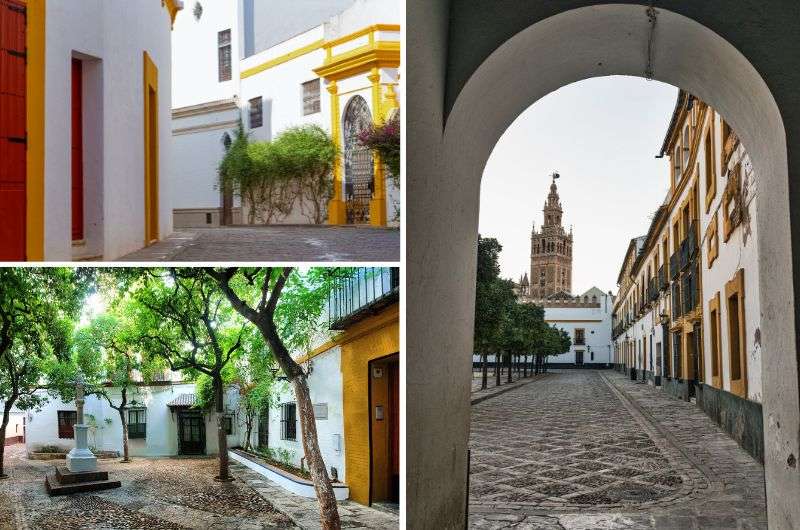
Barrio Santa Cruz
Don’t get too lost and keep moving along, eventually weaving your way towards Sevilla’s incredible cathedral.
Day 7, stop 3: Sevilla Cathedral and La Giralda Bell Tower
- Distance from last stop: Just a few steps away
- Time spent here: 1.5 hours
- Opening hours: Monday to Saturday 11 am–7 pm, Sundays 12 pm–7 pm
- Price: EUR 12 online, EUR 13 offline
Now for one of Sevilla’s biggest claims to fame: the Cathedral and the La Giralda Bell Tower!
The cathedral, finished in 1506 after over 100 years of construction, proudly claimed the title of the largest cathedral in the world, knocking Istanbul’s Hagia Sophia down to second place. Can you imagine the blow to Hagia Sophia's ego after holding the title for over a millennium?
Fun fact: The cathedral in Sevilla is currently the largest gothic church in the world, and it’s also the 2nd or 3rd largest cathedral and 3rd or 4th largest church in the world. I try to explain the vocabulary and details in my Sevilla article.
Seville's cathedral is built on the site of a former mosque, adapting to its square structure. The former minaret became the bell tower, La Giralda, which is why its floorplan is not in the shape of a cross like most churches.
It’s a massive cathedral with enough doors to confuse a maze runner. With its 80 chapels that could each pass for their own church, the place is seriously extra.
You will also want to climb La Giralda, the bell tower that Sevilla is so proud of. This tower is very tall and I loved the views of Sevilla from it.
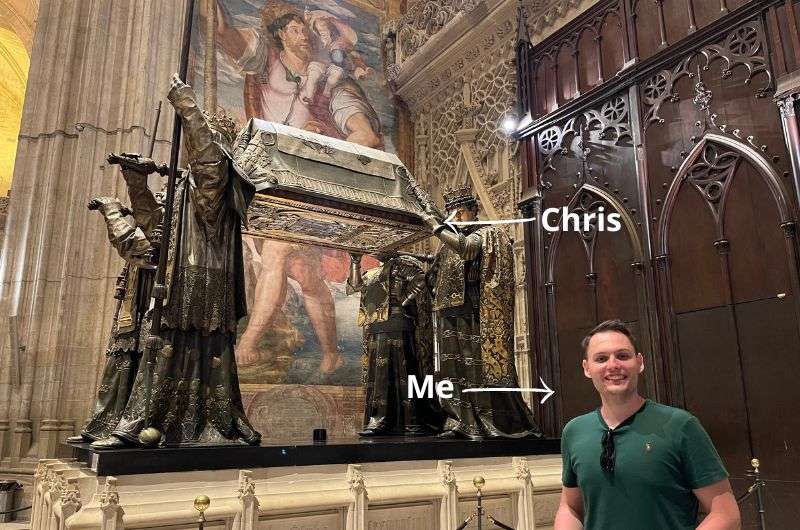
Me and Chris, world explorers
And don't forget about Christopher Columbus' tomb, which is the center of a fierce dispute over his final resting place. It actually holds his remains, even though Santo Domingo in Dominican Republic claim that their Columbus is the real thing.
Tickets to Sevilla’s Cathedral and Giralda Bell Tower
You can buy tickets online for EUR 12 or at the door for EUR 1 extra, but that way you risk them being sold out. It’s a good idea to plan ahead for this one and just get them beforehand. It also saves you the annoyance of standing in line once you get there.
If you already bought your ticket online, enter through the gate by the bell tower. If you want to buy your ticket in person, go through the main gate. It’s the southern entrance by the replica of the statue that sits atop La Giralda.
Day 7, stop 4: Flamenco museum (or tile museum alternative)
- Distance from last stop: 400 m (0.3 mi), a 6-minute walk
- Time spent here: 1.5 hours if attending the live show
- Opening hours: 12 pm–7 pm
- Price: EUR
It’s time for the flamenco! Sevilla is the home of the spirited and passionate dance—with lots of clapping and emotions flying around, it’s like a telenovela in musical form! If you want to experience it, Sevilla is one of the best places to do so.
Visit the Museo del Baile Flamenco to get some understanding of the meaning and history behind the flamenco, but don’t stick around the exhibition too long (it’s not that great).
Instead, look forward to attending one of the live shows—that’s the real highlight. It’s in a museum, yes, but it’s a really high-quality show. Just get there early and book tickets in advance, because they do sell out, and seats aren’t assigned and you don’t want to be in the back row.
Tip: There are dinner and flamenco venues around town called tablos, so if you want to make the flamenco the highlight of your evening, check out some of the best places to do that in my Sevilla Guide.
Alternative: Centro Cerámica Triana
- Distance from the cathedral: 1.3 km (0.8 mi), a 17-minute walk
- Time spent here: 1 hour
- Opening hours: Daily except for Monday 10 am–8 pm
- Price: EUR 2.10
If flamenco isn’t something you’d want to spend too much time on, what about tiles? In case you haven't noticed, Andalusia is the land of tiles. You can't take two steps without seeing a gorgeous ceramic masterpiece, thanks to those Moors and their super expensive taste.
So, for your next stop, you’ll head over the bridge to the not-so-touristy part of town and visit Centro Cerámica Triana. Plus, the Triana neighborhood is full of hip and artsy spots to visit while you're there.
The museum itself is in an old ceramics factory—a perfect fit for the part of town that produced the most tiles and ceramics. In fact, even the tiles on the fabulous Plaza de España were made here!
The museum isn't very big—you can breeze through it within an hour. But fear not, there are plenty of ceramics shops in the surrounding streets to extend your tile tour and stock up on some tiles as souvenirs for family and friends back home (just watch those luggage weight limits).
And that concludes your time in Sevilla, I’m afraid. Let’s finish this day by walking on mushrooms! Yes, really…
Day 7, stop 5: Sevilla’s Mushrooms aka Setas de Sevilla
- Distance from the flamenco museum: 550 m (0.3 mi), a 7-minute walk
- Time spent here: 1 hour to as long as you feel like it
- Opening hours: Daily 9:30 am–1 am
- Price: EUR 15
In the northermost part of Old Town is the largest wooden structure in the world—“The Mushrooms” (Setas de Sevilla). Why Mushrooms? Well, have you seen the picture?
Don't want to miss the light show that happens here in the evening—you'll feel like you're in a trippy fairy tale.
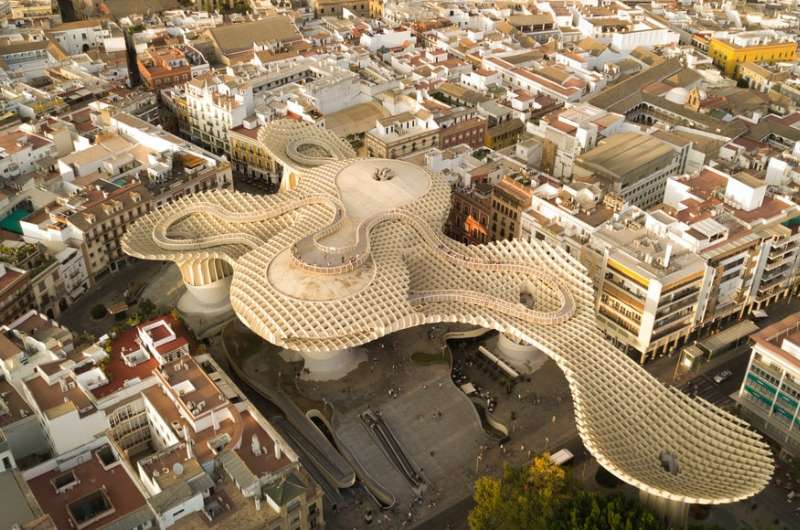
Isn’t that cool?
A little heads up: To really appreciate the beauty of this place, you'll need to ignore the shady underbelly. There are people at the base of the structure that made living under a mushrooms the best alternative to an actual house. But hey, no one's perfect.
There’s an elevator that takes you to the top of the setas where you can take in the sights from the winding walkways and platforms. There are a total of 5 floors at the Mushrooms. A unique view of the Cathedral can be seen from it, too. The restaurants, on the other hand, are nothing to write home about.
If you get your tickets online, note that there’s a time slot you need to limit yourself to, but at least you won’t get there and find out they’re sold out!
Day 8 in Spain: Granada: Come for the Alhambra, stay for the view (of the Alhambra)
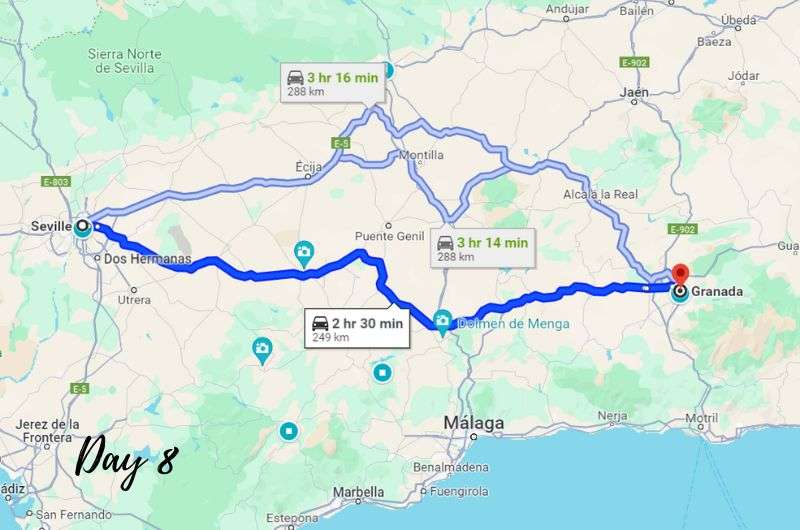
On day 8, you’ll be driving to the incredible Alhambra in Granada
Main sites visited on day 8: Granada’s Alhambra, Albaicín, Sacromonte, Montefrío viewpoint
Hotel recommendations: Hacienda Fresneda María by Charming Stay
Restaurant tips: Bar los diamantes | Bar La Trastienda | Bar La Riviera
Further reading: Guide: How to Visit the Alhambra | Granada Guide| Day Trips from Granada
This morning, hop into your rental car and drive 2.5 hours to Granada. Granted, you can also take the train, which takes about the same amount of time, but I prefer a car at this point in this Spain itinerary, because you’re so much more flexible.
Tip: If you decide to stay at Hacienda Fresneda María by Charming Stay, you’ll definitely need a car, because it’s pretty remote.
Your main goal for the day? Seeing Granada’s Alhambra. It’s not a palace—it’s a whole city! And it’s as marvelous as they say it is. No over-hyping here! Without it, you could easily skip over Granada, maybe except for the free tapas, which enjoy a similar level of popularity here.
Logistics and hotels: To move or not to move?
You could stay in Sevilla for the rest of your 2 weeks in Spain and use it as a base if you hate moving hotels. Or, you can pack you bags and move to the incredible Hacienda Fresneda María by Charming Stay. It is wonderfully secluded and extremely private with amazing views of the mountains and olive trees all around. Located pretty much in the middle of all of Andalusia’s best places, this is the hotel you want to stay at (unless you have kids… it’s adults only!).
And you won’t be sad to be further away from Spain’s best restaurants, either, since Hacienda Fresneda María’s own restaurant is Michelin-level in both food and service.
Day 8, stop 1: The Alhambra
- Time spent here: 4 hours
- Opening hours: Daily 8:30 am–8 pm (closes at 6 pm from October to March)
- Price: EUR 18
The Alhambra is the most impressive Moorish palace complex in the world. There’s a reason you need to buy your tickets months in advance!
It’s a sprawling complex that is a city of its own, meaning that 3–4 hour time expectation really isn’t exaggerated. It’s also on top of a hill, resulting in you having a great workout whether you want one or not.
The palace complex was constructed by the Arabs, specifically the Nasrid dynasty in the 13th century. The Nasrids were a Muslim dynasty that ran Granada for 250 years, marking the last Muslim kingdom on the Iberian Peninsula. They built a luxurious palace complex on a hill, essentially creating a completely separate Muslim city from the rest of Granada. Throughout their reign, each ruler added their own touches until it became one of the most spectacular and now best-preserved palaces of the historic Islamic world.
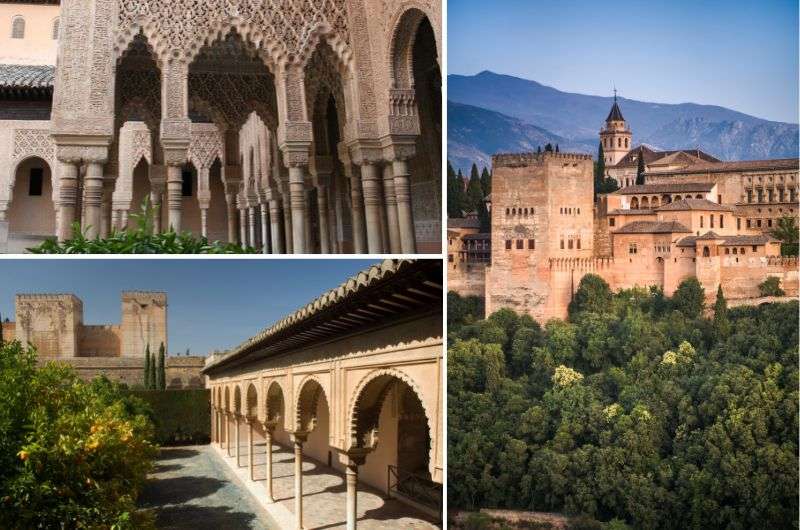
This complex will take you some time
Tickets to the Alhambra
Get your tickets up to 3 months in advance from the official website. Plan your visit to all the other parts of the complex around the 1-hour time slot indicated on your ticket for the Nasrid Palaces.
Kids need their own tickets even though they enter for free.
Important: Make sure to have your passport with you when you enter. Your ticket has your passport number on it and it will be checked several times during your visit. They are strict about this!
Visiting the Alhambra
To get to the main entrance of the Alhambra, walk down Cuesta de Gomérez. This charming street leads you to the Gate of the Pomegranates (Puerta de las Granadas) and straight to the Justice Gate (Puerta de la Justicia). You will be walking through an avenue surrounded by trees and some fountains for about 0.7 miles (1100 km).
The Alhambra is split into three main areas: the Alcazaba (fortress), the Nasrid Palaces, and the Generalife (gardens), and your ticket and ID will be checked when entering each of these areas.
There are more ways to walk up, namely the Cuesta del Rey Chico, o de los Chinos, that leads up to the back of the Alhambra through a more of a forest landscape. It’s a good route to take back down to the city if you end your walk through the Alhambra in the Generalife gardens.
The Alcazaba is at the bottom of the Alhambra right next to the Nasrid Palaces.
I have a thorough guide on how to visit the Alhambra, including how to get to and from the Alhambra and what to see inside (and how not to miss your time slot for the Nasrid Palaces—the highlight), and many FAQs about this epic monument. Read up before you go!
After the Alhambra, you can look around Granada a little more, mainly to see some interesting neighborhoods that offer stunning views of the Alhambra. In case you haven’t noticed, the Alhambra is very much the focal point in Granada.
Day 8, stop 2: Albaicín and Sacromonte neighborhoods
- Time spent here: Up to 3 hours including lunch
- Price: EUR 5 for the cave museum
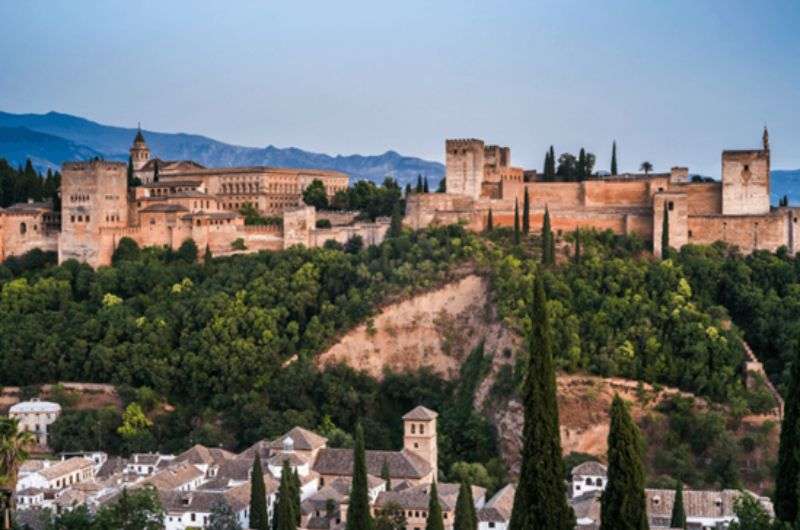
The Alhambra at sunset as viewed from the Albaicín
The Albaicín and Sacromonte are neighborhoods in the hills beside the Alhambra. You know what that means—awesome views of the Alhambra!
Go to the Plaza de San Nicolás in Albaicín for the best ones, and even see the peaks of the Sierra Nevada in the background, with the entire city of Granada right below you.
In Sacromonte, the Gypsy quarter of Granada, the higher up you go, the better the views get. The dwellings in the Sacromonte neighborhood are carved right into the mountain. Visit the museum to learn more about these former cave homes, and even visit some recreated ones. Tickets are EUR 5.
Hungry? Stop at one of the fantastic tapas restaurants around Plaza Nueva for the best restaurants: Bar los diamantes, Bar La Trastienda, or Bar La Riviera are all great choices.
Free tapas! Granada is famous for serving its tapas for exactly 0 money. You just pay for drinks and tapas land on your table! More drinks, more tapas, it’s delightful. More about the tapas culture in Granada.
Day 8, stop 3: Montefrío
On your drive back to your hotel, make a detour to one of the ten villages with the best views in the world (as chosen by National Geographic, not me this time)—Montefrío.
To judge the view that won Montefrío its “best view” title, head up to the National Geographic viewpoint (Mirador del Paseo). It’s right on the road, so you can be done in a few minutes.

Montefrío
If you have time, you can also head up to the castle, try to find some of Montefrío’s award-winning cheese, or see the peculiarly round church, Iglesia de la Encarnación, poking up from the village’s center.
More about Montefrío in my article about the Best Day Trips from Granada.
Tomorrow, you’ll be starting your day with some adrenaline, so rest up!
Day 9 in Spain: Caminito del Rey and Ronda
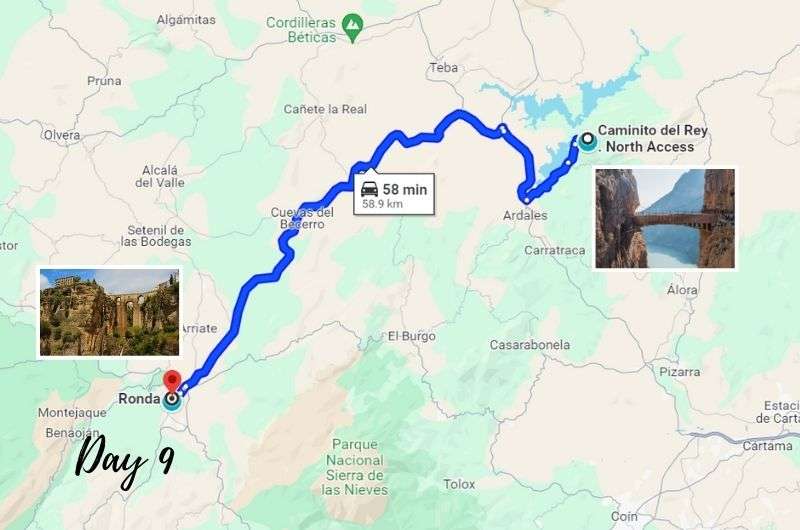
Day 9 of your 10-day itinerary: Caminito del Rey in the morning and Ronda in the afternoon
Main sites visited on day 9: Caminito del Rey, Ronda’s bridge and viewpoints, Ronda Old Town, Bullfighting Museum or Arab Baths
Hotel recommendations: Hacienda Fresneda María by Charming Stay
Restaurant tips: Caminito del Rey: Bar Restaurante La Ermita | Restaurante El Mirador Ardales | Ronda: Restaurante Las Tablas | El Lechuguita | BlackCoffee
Further reading: Top Places in Andalusia | Ronda Guide | Day trips from Granada
Today’s an exciting day, because you’ll start off with one of my favorite experiences in Andalusia, walking the vertigo-inducing walkway of Caminito del Rey! Followed by a more chill afternoon in picturesque Ronda.
Day 9, stop 1: Caminito del Rey
- Distance from hotel: 75 km (47 mi), about a 1-hour drive from Hacienda Fresneda María by Charming Stay (or 2 hours from Sevilla)
- Time spent here: 3.5 hours
- Opening hours: Daily 8 am–2:30 pm or 5 pm depending on the season
- Price: EUR 10 for self-guided tour, EUR 18 for guided tour, EUR 2 for parking and EUR 2.50 for shuttle bus
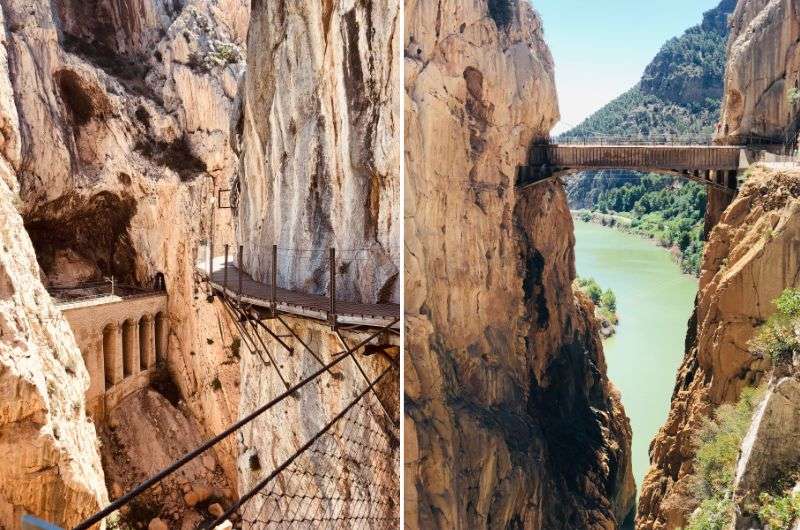
Great for vertigo!
Caminito del Rey is one of my top two destinations in Andalusia, and is for sure the best natural spot to visit in southern Spain. Take sunscreen and a hat, because it gets unbearably hot! Don’t make the same mistake we did and think “oh, it’s a gorge, it’ll be in the shade”. NOPE.
It’s a series of walkways bolted into the rock face 330 feet (100 m) above the gorge floor, so maybe also take a diaper if you can’t deal with heights. This experience is a combination of nature and adrenalin. You’ll be happy to notice that the path you’re walking on, built in 2015, is much better than the old one still visible under it. You would not want to be on the old one. Neither did those that fell to their death from it before it was repaired.
The drive from Hacienda Fresneda María by Charming Stay takes about an hour—aim to get an early start, you have a full day ahead. Beware that you need to book tickets months in advance if you want to go without a guide. For guided tours, weeks in advance is usually enough.
Secret tip: If you get a guided tour and find out that your guide moves at the speed of a sloth, you can just ditch the tour and continue on your own (like we did). This could be helpful if you want to buy tickets for a day where self-guided tours are already booked solid.
You will get a time slot when you buy your ticket and will need to get to the parking area at the visitor’s center an hour ahead of time to be on the safe side, because the entrance of Caminito del Rey is a 20-minute walk from the parking lot (look for the tunnel). You can also use the shuttle bus to get to and from your car, which, in the heat, can be very useful.
The actual Caminito del Rey hike takes around 2 hours, and while it's mostly flat, don’t let that fool you into rushing through. This is a place to savor, not just a trail to conquer. The views here are nothing short of jaw-dropping—think sheer cliffs, turquoise waters, and panoramic vistas that will leave you speechless. You’ll find yourself stopping every few minutes to snap photos because, trust me, your Instagram is about to get an upgrade. Soak it all in—this is one hike you’ll never forget!
Day 9, stop 2: Ronda
- Distance from last stop: 58 km (36 mi), about a 1-hour drive
- Time spent here: 4 hours
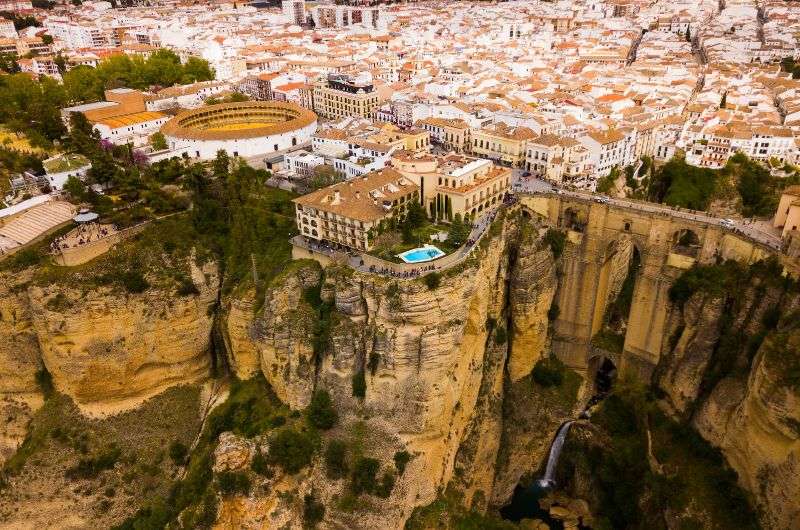
Ronda
A tiny town perched up on a limestone rock formation, made famous by a spectacular bridge over the gorge in the middle of it—that’s Ronda, your next stop on your almost last day in Spain. Let’s make the most of it.
Start by driving for 45 minutes from Caminito del Rey. Park at one of the many parking lots, we found this parking lot good (and cheap for about EUR 1 per hour).
Here are the main things to see in Ronda:
Bridges and viewpoints
Ronda’s top claim to fame is the New Bridge (Puente Nuevo). It’s the highlight and is worth braving the crowds that flock here. You can stare at the views of the landscape from it, see the Rio Guadalevín flowing below it, but you won’t really be able to see the bridge itself.
That’s why you’ll spend most of your time in Ronda walking to and staring from various viewpoints.
First, make a stop at Mirador de Aldehuela, which is right behind the bridge. Behold, the back of the bridge! (Do bridges have backsides?)
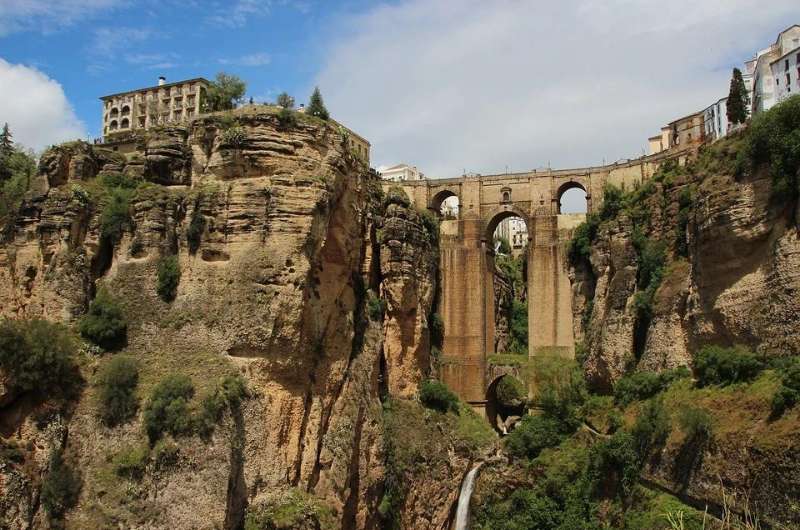
View of New Bridge in Ronda from a viewpoint in the gorge
Then, go to the viewpoint called Mirador de María Auxiliadora, a little ways south from the bridge. There’s a path into the gorge that is apparent from there, and you just stay on the trail and keep hitting better and better spots to take that pic of the bridge. You’ll know when you hit the end, the best spot of all. Then it’s back up the hill!
Ronda Old Town
You’ll walk through parts of Old Town during your search for bridge viewpoints. Calle Armiñán is the main drag, with shops, bars, and historical buildings worth your gaze.
Two to look out for specifically are Casa del Gigante, which is a private home built in the 13th or 14th century and is one of very few belonging to Nasrid architecture. This is what a house of a wealthy Muslim family would have looked like in that time.
The Palacio Mondragón is a palace converted into a museum. You can learn about the history of the region here, as well as admire the two styles it presents: the Mudejar and the Renaissance.
The Iglesia de Santa María la Mayor is a mosque turned into a Catholic. For EUR 3, you can climb up the winding stairway to a viewing platform for some lovely views. Because I’m sure you haven’t had much of those this whole stay in Ronda!
Next, there’s the bullfighting museum and the Arab Baths. Due to time constraints, you may need to pick just one; I’d go for the bullfighting museum in that case, unless you’re really short on time, in which case Arab Baths it is.
Bullfighting Museum in Ronda
The bullfighting arena at Plaza de Toros (full name: Plaza de Toros de la Real Maestranza de Caballería de Ronda) is considered the birthplace of modern bullfighting. It was here that, in the 18th century, a matador named Pedro Romero got into the arena with a bull on foot, not horseback. This arena, along with the one in Sevilla, is the oldest in the world.
It’s really nice with two stories. There is a museum at the arena and you can take a tour of the bullfighting ring on your own with the help of an audio guide for EUR 11. I consider it the most interesting place in Ronda besides the bridge.
Bullfights do still happen here, and even though I have a whole big, strong opinion on those, I think it makes sense to learn about the tradition when you’re in Spain.
Tip: If you happen to be in town in September, you might be there for the annual ‘Feria Goyesca de Pedro Romero’, a festival focused on the glitz and glam of old-school bullfighting. There is a procession of horse-drawn carriages with everyone, including the matadors, dressed in 18th century costumes.
Arab Bath
Ronda’s Arab Baths are some of the best preserved baths of this type in all of Andalusia. They were built in the 13th century and used by Muslims and visitors alike to purify themselves before visiting the mosque, and just as a sanitary facility in general.
Tip: You could imagine the procedure to be similar to what we experienced in a hamam in Istanbul.
The Arab Baths are small, so you’ll be done in 30 minutes max. Tickets cost EUR 5.

Arab Baths in Ronda
There are three main rooms: the cool room was for relaxing and cooling down (and chatting for hours with your neighbor about your other neighbor), the warm room provided services such as massages and perfumes (and some more talking with Bob), and the hot room was very steamy, like a sauna. Repeat until you’re all bath’d out!
The baths themselves are partially underground, though the first room, formerly the changing room, has lost its ceiling. The other rooms are intact.
The warm room also shows a great animation about the baths and how they used to be used.
There, you did it, you’ve seen Ronda! As a last goodbye to Ronda, head to Mirador de Ronda, a viewpoint that’s part of a park called Paseo de Blas Infante. This time, you’ll be staring out beyond Ronda, and if you happen to be here at sunset, you might even think it’s the prettiest sunset you’ve ever seen.
Day 10 in Spain: Gibraltar (so, not technically Spain)
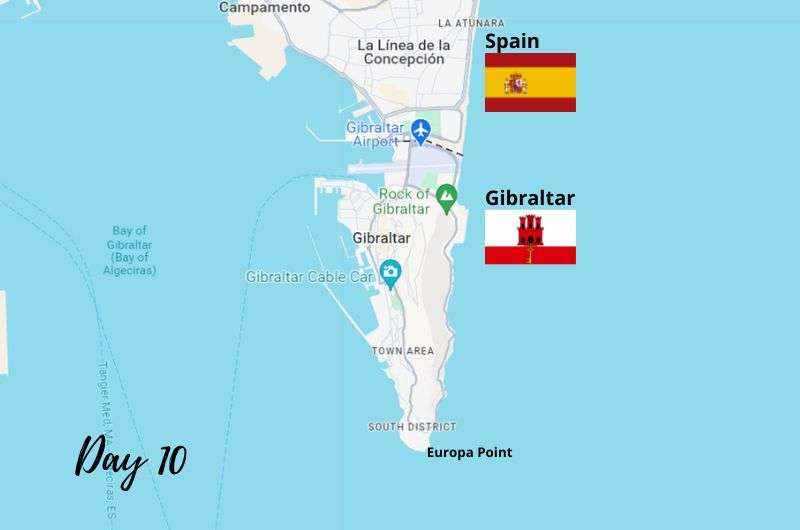
On your last day in Spain, you’re technically leaving Spain to visit another country
Main sites visited on day 10: Beaches on the way to Gibraltar, The Rock in Gibraltar, Europa Point
Restaurant tips: Jury's Café and Wine Bar | The Yard
Hotel recommendations: Hacienda Fresneda María by Charming Stay
Further reading: Most Beautiful Beaches in Spain | Gibraltar Guide | Unusual and Well-Known Things to Do in Gibraltar
Next up, you’ll leave Spain, enter the UK, and then go back to Spain. And you might even see Africa! All in a single day.
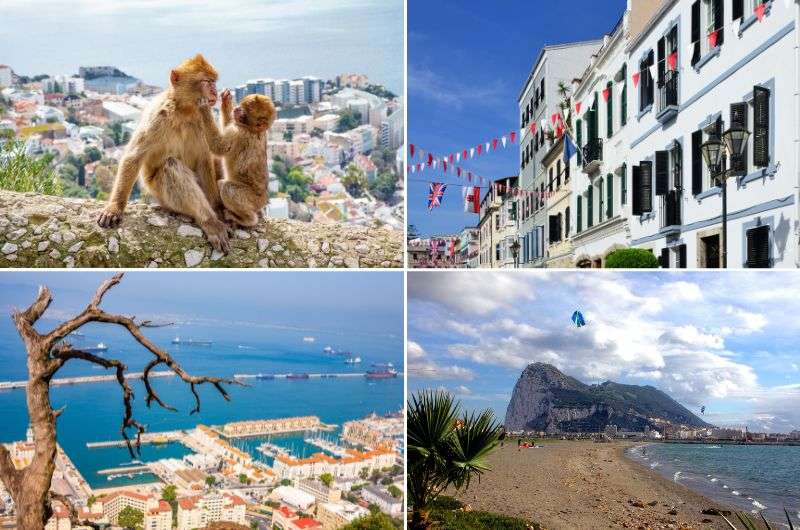
We will conclude the itinerary with a trip to Gibraltar—funny enough, my favorite place “in” Spain!
Gibraltar is a British Overseas Territory at the southern tip of the Iberian Peninsula, about 2 hours from Hacienda Fresneda María by Charming Stay and a little longer from Sevilla. I had low expectations when I first visited, by boy oh boy, was I proved wrong! I LOVED Gibraltar and I think it is an unmissable stop on your 10-day itinerary for Spain. Heck, any Spain itinerary should include it.
As a bonus, if you’re coming from the Malaga direction, you can stop by some of Spain’s prettiest beaches on the way.
Day 10, stop 1 (optional): Beaches near Marbella or Estepona
- Distance from hotel: 110 km (68 mi), a 1-hour drive to Marbella, an extra 15 minutes to Estepona
- Time spent here: 1 hour
- Opening hours: Always open
- Price: Free
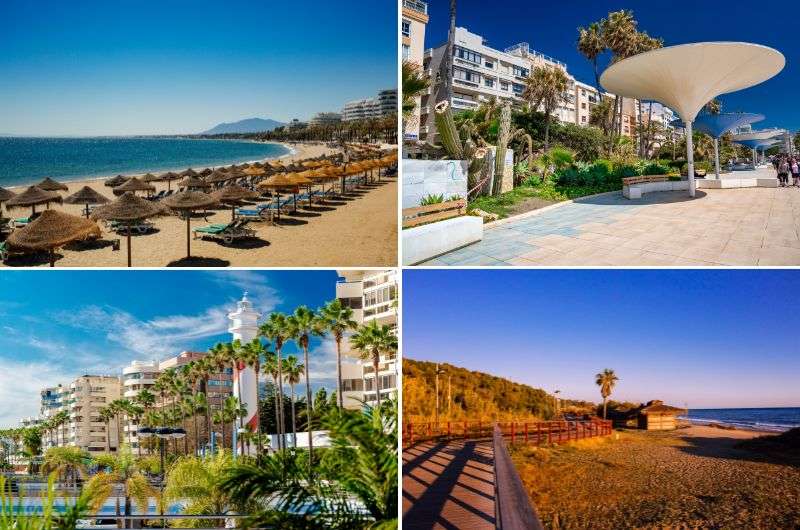
Take your pick!
You’ll be spoiled for choice for a beach stop (if you want one). If you prefer a natural beach, complete with a wooden beach walkway, head to the Senda Litoral Coastal Trail. If you packed your fancy swimming suit, continue on to Spain’s version of Saint Tropez, Marbella. For less conceited folks, the charming beach resort town of Estepona will probably be more up your alley. La Rada Beach is right in front of the cute Old Town. Complete with historical buildings with flowers in blue flower pots, castle ruins, towers, and fountains covered in tiles, it is Andalusia in mini form. Like an Andalusia tapa!
But don’t hang around for too long, because you need to see Gibraltar in however long you have left in the day.
Day 10, stop 2: Gibraltar’s The Rock
- Distance from last stop: 42 km (26 mi), a 30-minute drive to La Linea
- Time spent here: 4 hours
- Opening hours: Daily 9:30 am–7 pm (only until 6 pm from November to April)
- Price: GIP 38 (USD 50) for the return cable car ride and entrance to The Rock nature reserve with all its attractions

The massive Rock of Gibraltar and me
When entering Gibraltar from Spain, you need to cross the border, so have your documents in order, don’t forget your passport at your hotel, etc.
There are often long lines of cars at the border and parking in Gibraltar is a pain. Go ahead and leave your car in La Linea on the Spanish side and just walk through the border. If you purchase your tickets to The Rock online (or at the border), you get a free shuttle from the border to The Rock cable car station anyway.
You can check the online stream to determine if there is a hold up at the border if you really want to drive in. I have more detailed information about getting into Gibraltar and the traffic and parking situation in my full Gibraltar article.
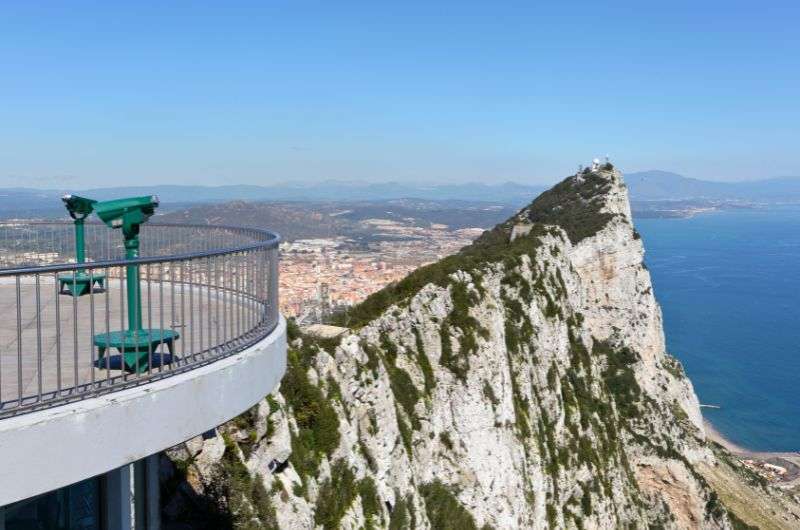
No shortage of viewpoints on The Rock
The highlight of any trip to Gibraltar is a visit to the Rock, the huge limestone mound that takes up most of the land Gibraltar is on. The Rock is about 1,400 feet high (420 m) and the top of it is a nature reserve with the most magnificent views and some gnarly and surprisingly big monkeys.
Beware: Those monkeys are assholes and use humans as trampolines for bouncing between trees. I saw it more than once and it didn’t look fun (for the human).
The ticket for a return cable car ride and entrance to the nature park with all its attractions (like the suspension bridge, the Skywalk and the tunnels) costs GIP 38 per person (about USD 50).
The ride up or down The Rock takes 6 minutes. There are many trails to walk on The Rock, and if the sky is clear, you’ll see all the way to Morocco. The views are crazy good, so really budget enough time for The Rock, it’s easy to spend half a day there.
The are other attractions, too, like the Skywalk and the Great Siege Tunnels, that’ll take up extra time. Don’t miss the chance to walk all the way to the end of the tunnels. You’ll get to the balcony on the other side of the Rock!
Lots of details on visiting The Rock, what to see, why, and how, are all in my Gibraltar day trip itinerary.
Day 10, stop 3: Gibraltar’s Europa Point
- Distance from last stop: 3 km (1.8 mi)
- Time spent here: 30 minutes
- Price: Free
Europa Point is he most southerly point of the Gibraltar peninsula, just one high-five away from Africa. And man, does it deserve a high-five for the views! On the clear days, you can even see Morocco from Europa Point. The destination you’ll be aiming for is Trinity Lighthouse.
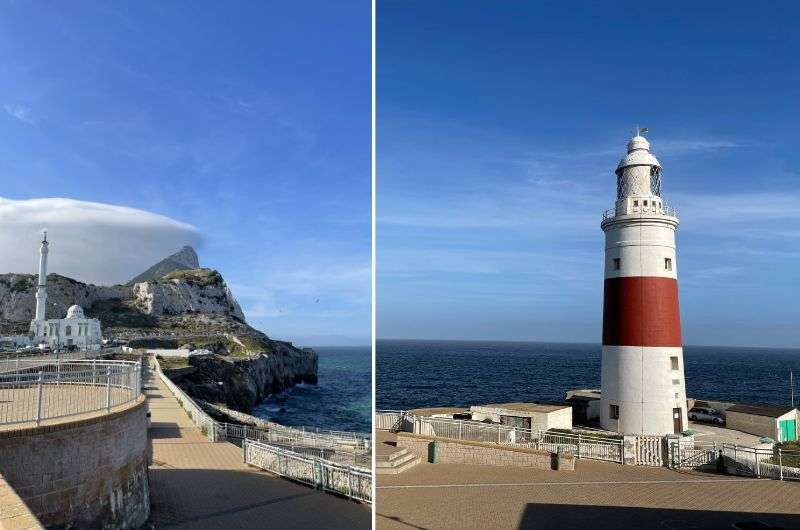
Europa Point
The lighthouse deserves an award for the second most Instagram-worthy place in Gibraltar. Let's be real, the main reason to visit Europa Point is for the views. The scenery of all those boats passing by is impressive. But for me, it was the lighthouse.
Europa Point is quite a walk from the main part of the island (there’s also a bus that can take you to the end). Beware the wind can get immensely strong up there. Take a look around and then head back to town.
Day 10, stop 4: The city
- Distance from last stop: 3 km (1.8 mi)
- Time spent here: 2 hours including food and drinks
There’s not much else to do in Gibraltar, but that’s ok, you probably don’t have time for anything else anyway. If you fancy a little stroll or a food break before heading back to your car, walk through Main Street and stop at my favorite restaurant in town, Jury's Café and Wine Bar. It’s small and charming and the fish and chips with beer were great.
If you like to enjoy your meal with a side of plane engine roars, head over to possibly the most modern part of Gibraltar, Ocean Village. There are tons of bars and restaurants here at this northern end of the marina.
After that, it’s time to head home… err, to your hotel. And then tomorrow, to your actual home, because sadly, your time in Spain is up.
And with that, amigos, your 10-day whirlwind trip through Spain comes to an epic close. You've conquered Gaudí’s wonders, stood in awe of Spain's grand cathedrals, and soaked in views that made your camera work overtime. Now it's time to say goodbye—until the next adventure. Adiós muchachos, and hasta la próxima!
You might also be interested in reading:
- 10 Best Places to See in Mallorca
- 5 days in Barcelona (with day trips)
- How to Visit the Alhambra in Granada
- Andalusia Itinerary: Southern Spain in 10 Days
This post contains affiliate links. I earn a small commission if you make bookings through my links, at no additional cost to you. Thank you for your support!


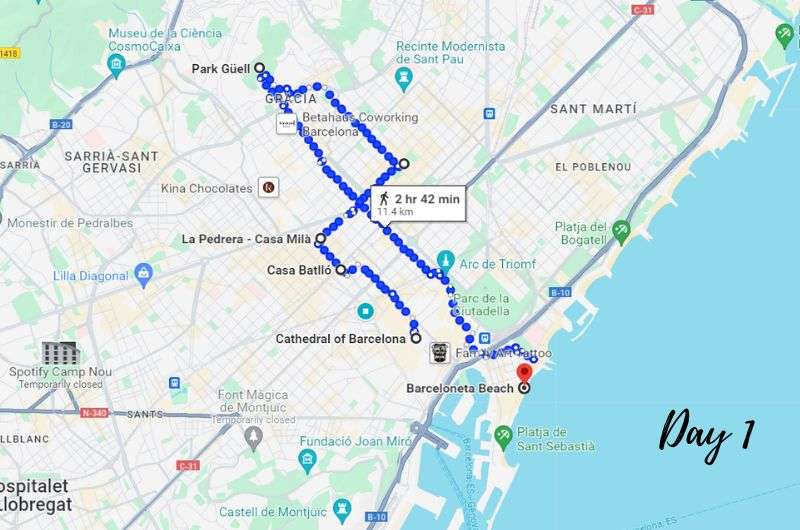
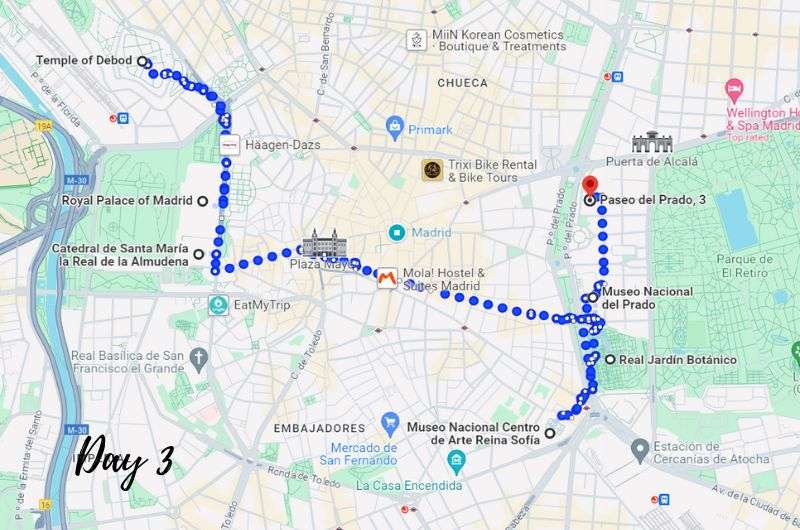
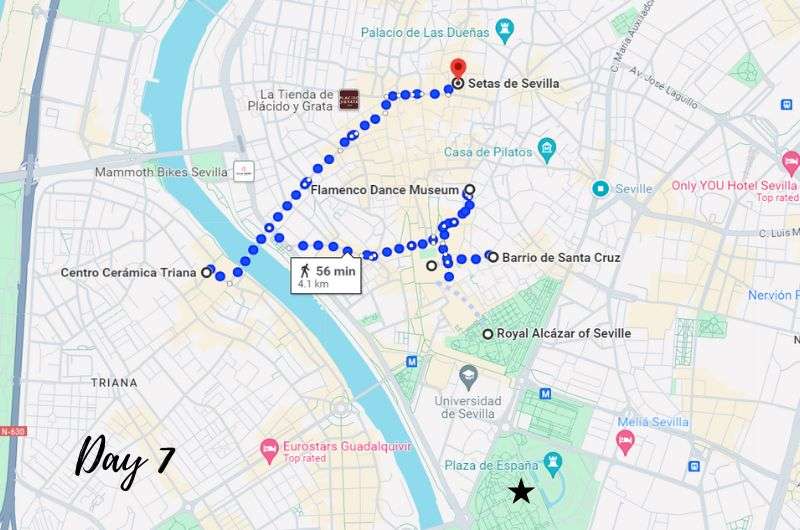
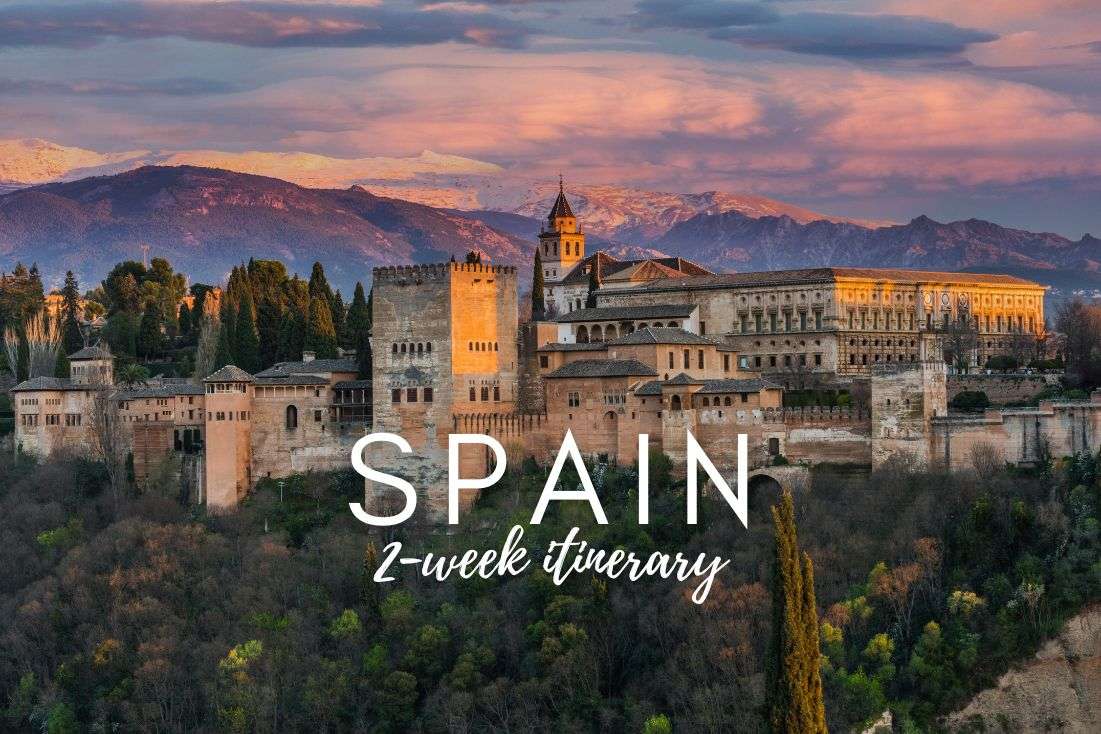
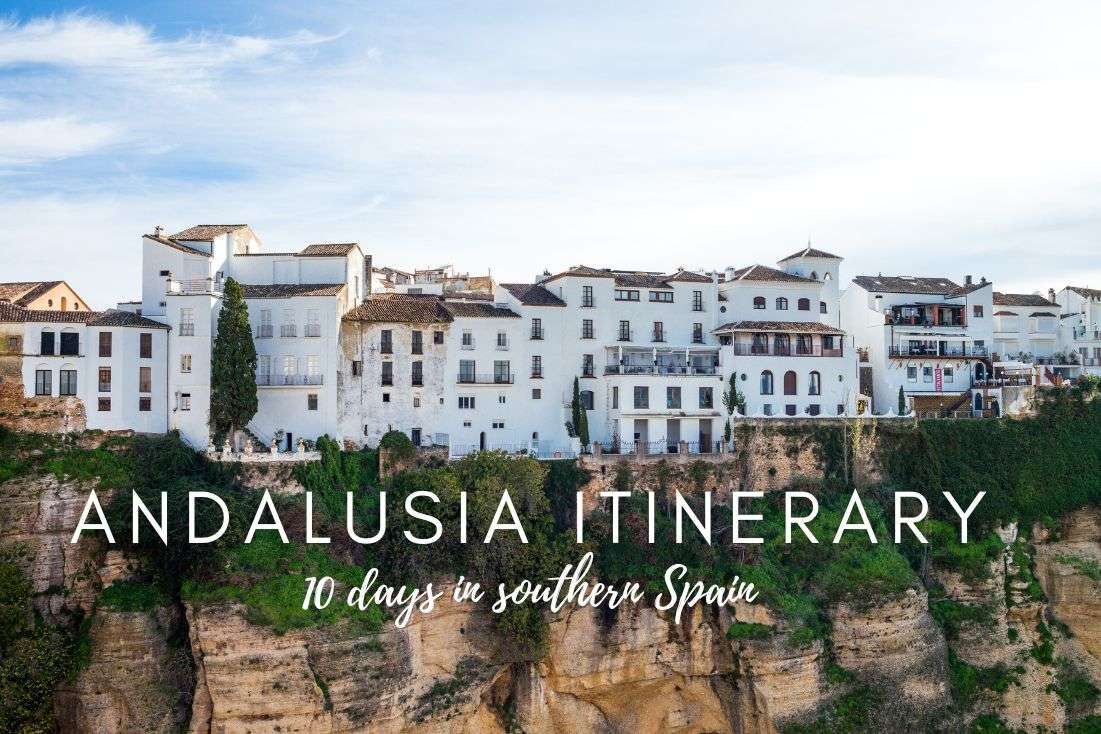
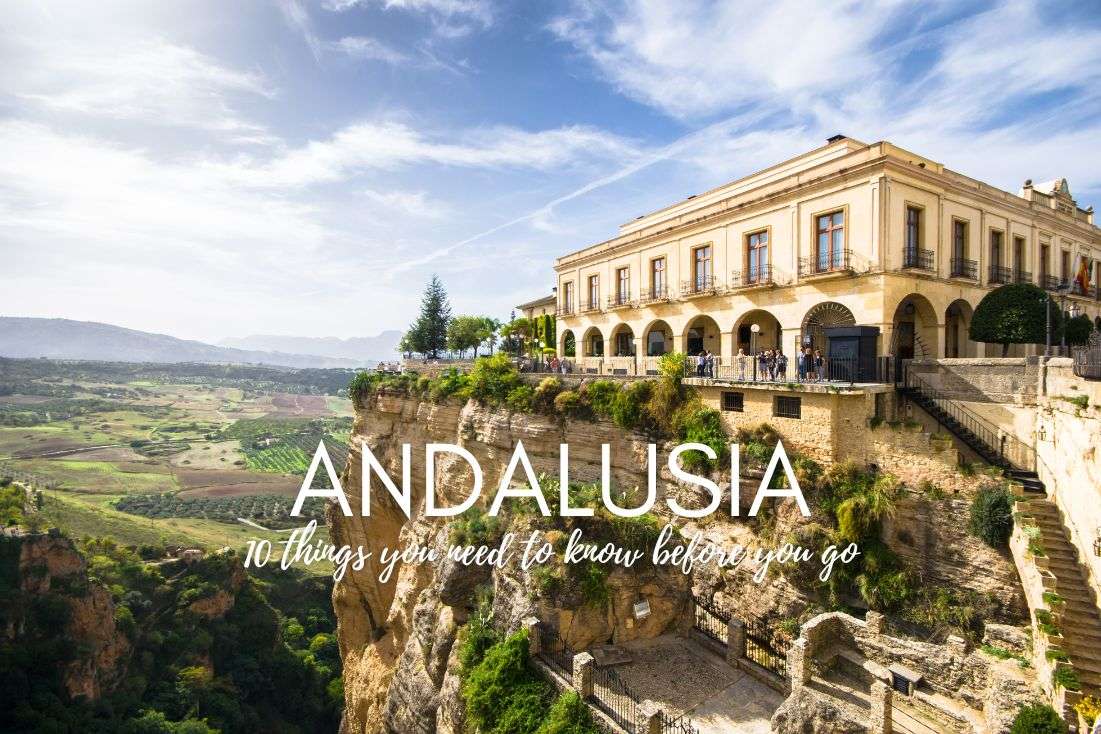





Comments | Thoughts? Give us a shout!